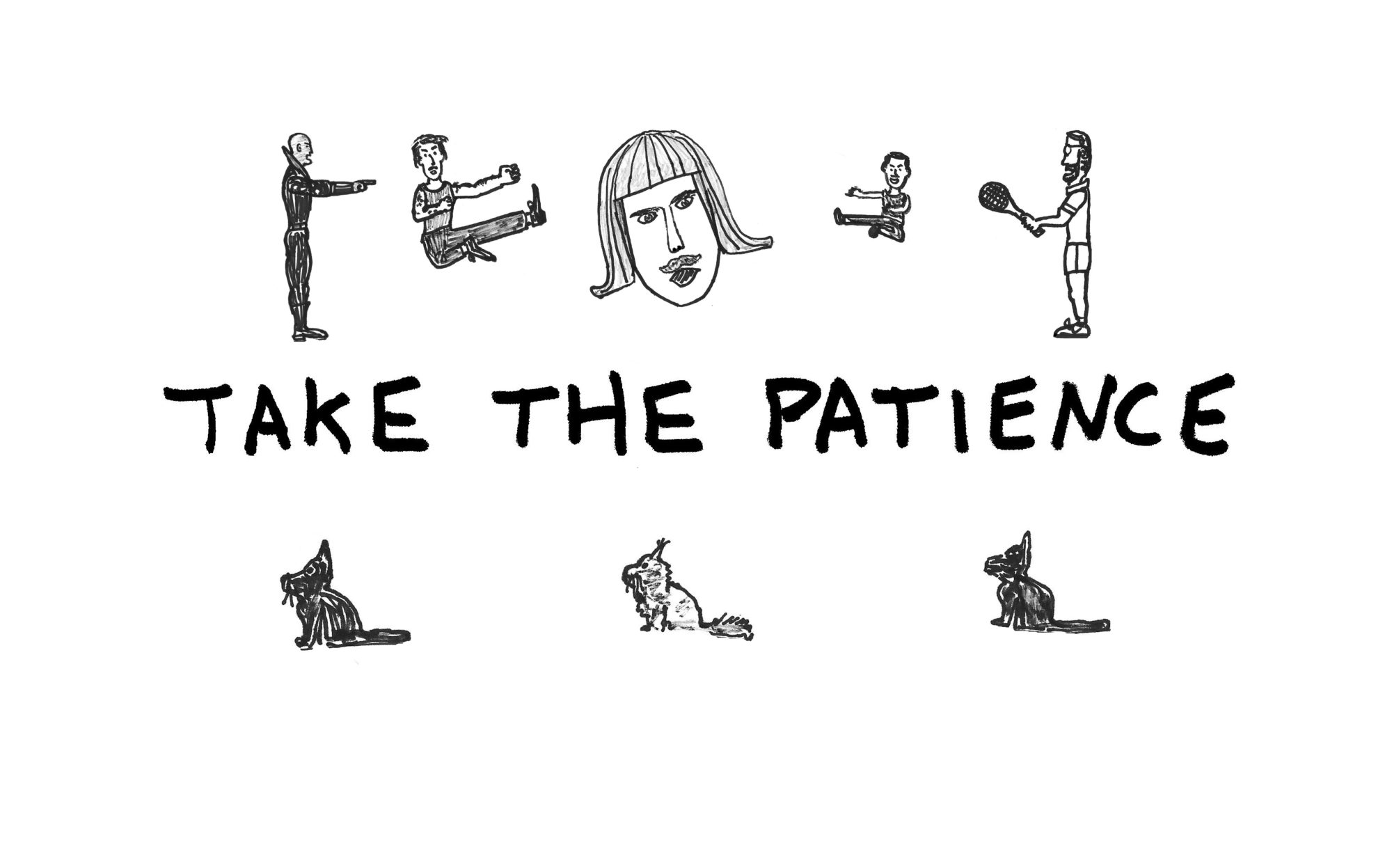A destination seems more special when the journey is more strenuous. Getting to Nepal was not excruciating (nothing compared to barfing your guts out on a wind-powered boat for months as was en vogue in old times) but with an eleven-hour layover in Istanbul, it felt a bit layered getting there.
People are not meant to stay in an airport for 11 hours. There’s only so many times you can go to the food court and think about what you will eat when it’s time to eat. After hour four, you start to enter this Andy Dufresne prisoner mode of thinking “maybe I’ll start tunneling through this wall to see where it goes.” More accurately, you literally become Tom Hank’s character Viktor Navorski in The Terminal where he lands in JFK airport to discover his passport is no longer valid since the tiny country he is from dissolved during his flight. While immigration officials figure out what to do with him, he’s forced to wander the airport terminal for several days. Soon he figures out the patterns and rhythms of airport life and creates a funny micro life in the confines of the terminal.
Similarly, by the end, I had a good feel of the Istanbul international terminal. I knew where everything was. I knew where the good food places were. I saw the level of anger a janitor shows when a complete idiot tries to smoke a cigarette in a bathroom stall. I discovered if you find an empty departure gate, you have roughly 45-70 minutes to fall asleep there before it starts to get crowded with passengers waiting for their flight. This last discovery led me to finding an empty gate, reading for a short while, falling asleep for 15-45 minutes, waking up to lots of people around me, and then leaving to find another empty gate. I can conservatively say that I took naps in about 70% of Istanbul’s International Terminal gates. Other people appeared to be doing the same thing which meant you may cross paths with the same travelers every third gate or so. Hopefully this will be as close as I get to being homeless.
For good measure, once up in the air, the Istanbul – Kathmandu leg of my trip was lengthened a couple hours due to an unplanned extension of the flight path followed by too much air traffic at Kathmandu. The latter caused us to circle over Katmandu Valley for 40 minutes, granting us rich views of the Himalayas and Everest multiple times. The reason the flight path was extended was that we were forced to avoid Pakistani airspace. In February, terrorists from Pakistan set off an attack in the Indian city of Pulwama which led India to launch a strike on a terrorist camp in Pakistan which led to a failed Pakistani retaliation. All of this escalation caused a closure of Pakistani airspace, causing delays and longer flights.
When I exited the airport, I got a wonderful vibe from the people. They seemed to have that easygoing, balanced, genuine nature I have seen in Thailand and the Philippines…all countries that have no desire for world domination or at least the domination of their neighbors. The staff at Kathmandu Embassy Hotel was precious as was Nirmal, the owner who also ran the travel/tour agency that arranged my entire trip. I believe he should feel compelled to create an ab workout called Ab-Nirmal: “Ab-Nirmal…if you want abs that are so toned, they’re ABnormal, then you need Ab-Nirmal!”
The following morning I ate breakfast on the hotel’s roof top eating area. As I ate, I watched the morning’s fog slowly get replaced by a haze of dust and pollution. After eating, Nirmal offered to give me a ride to the neighborhood of Thamel on the back of his small motorbike, allowing me to become the white American date he never had or wanted.
As we rode along, I felt like a blood cell flowing through a series of veins, appreciating all the near misses that were not upgraded to collisions. We crossed over a main road into Thamel and motored our way through a network of tight shop-lined streets that gave an overall sensation of eating your way through a Pac Man board. Thamel was the place to go before your trek. It’s loaded with tour guides and shops that sell and rent hiking gear. I bought a winter coat, pair of trekking poles, and water purification tablets for about $70.
Upon the recommendation of many, I walked west and then up to Swayambhunath, a temple home to Buddhists, Hindus, and monkeys. There were monkeys climbing all over this site, probably feeding off the tourists. Less cute and more irritating was another pest who also feeds off tourists. A young man approached me at the base of the long stairway to the temple. He said he worked at the temple and began to explain the place in detail. A couple minutes in and about 100 steps up, I asked, “Who pays you to work here? The government?”
“No,” he said, “people like you do. I asked him how much but he would not answer definitively. I didn’t like where this was headed so I gave him 200 rupees and thanked him for his time. He was upset by this, saying I was supposed to pay him more. I advised him in the future to communicate his system more clearly to people before initiating a guided tour and proceeded up the stairs.

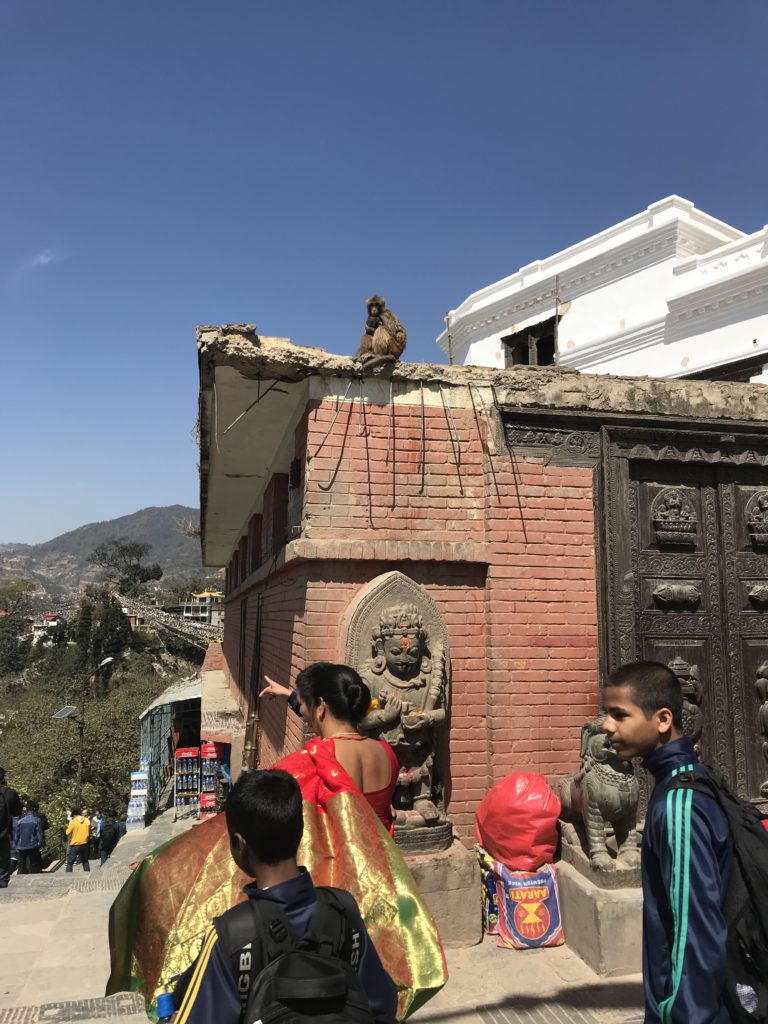
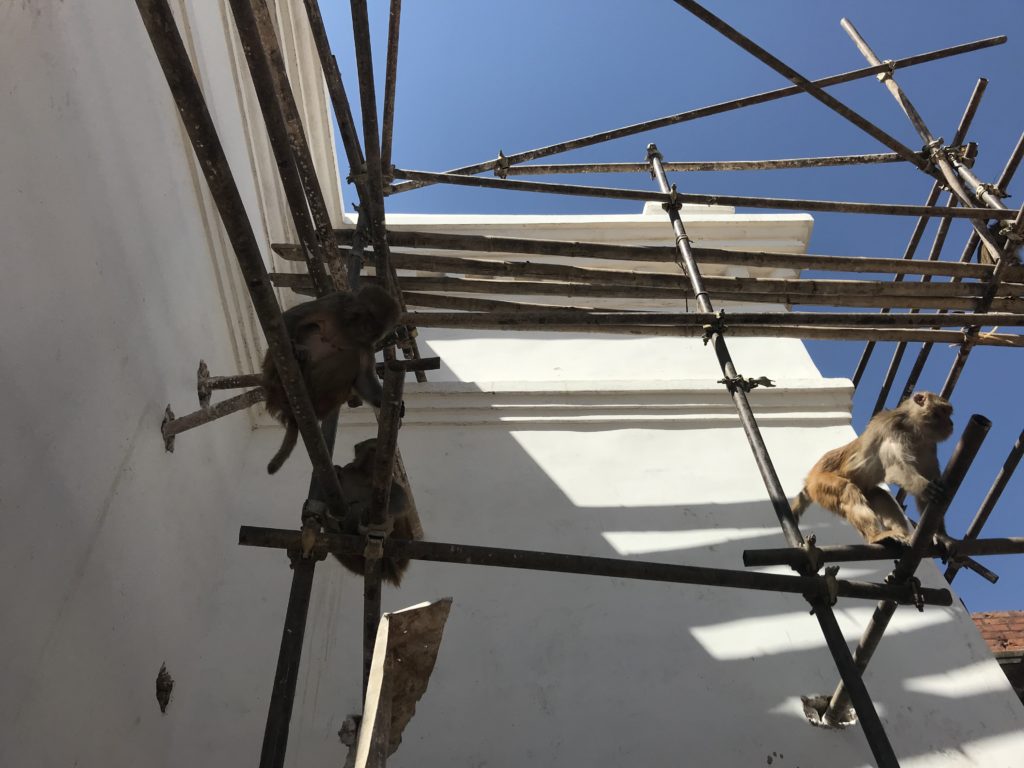
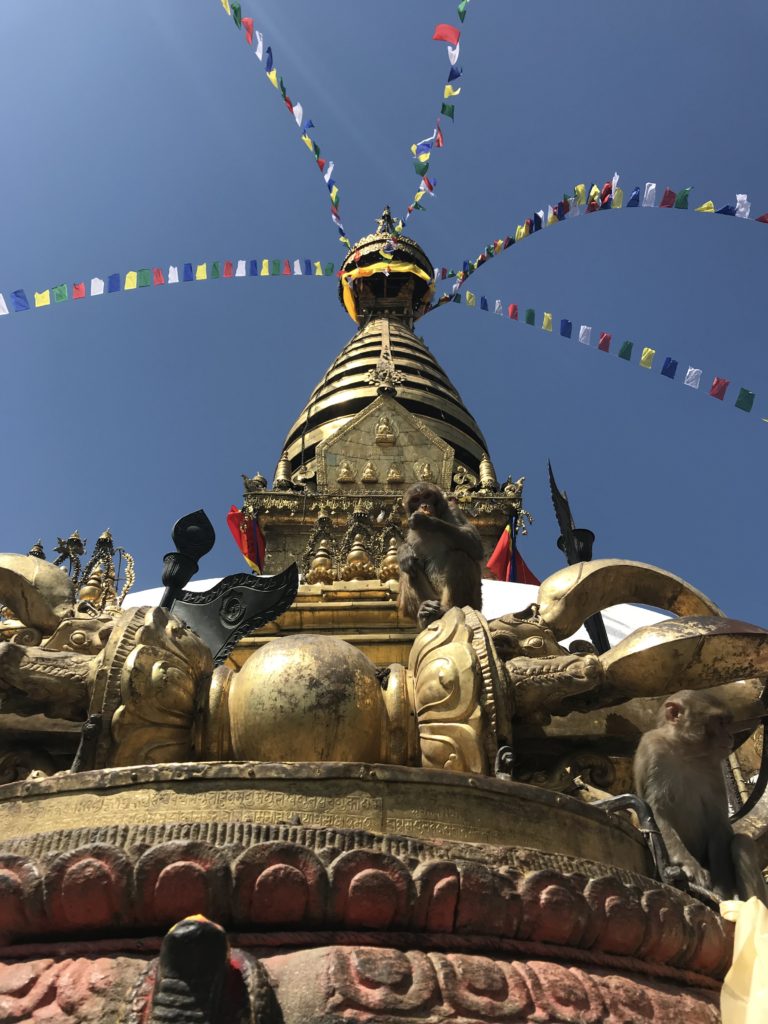
I eventually walked back to Thamel and met Nirmal in his travel guide office. While we chatted, a Swiss man of about 50 named Andy walked in and greeted us. He had known Nirmal for over 20 years and was one of so many westerners that make annual and biannual pilgrimages to Nepal. I told Andy that I visited Zurich and Stein Am Rhein years ago. I commented how picturesque Stein Am Rhein was which caused Andy to reflect on how unfortunate it was that due to its close proximity to Germany, the US accidentally bombed it in WWII. I said I was sorry. He laughed.
As I looked around, I marveled at this robust tourist business that slowly came to life after 1950, following the removal of the Rana regime which essentially opened Nepal up to the world. Before 1950, electricity was only to be found in Kathmandu Valley. Outside the valley, there was no electricity, literacy rates of 2-5%, and a massive death rate. No exaggeration is made when people say that before the 1950’s, most of Nepal was living in a Medieval environment.
One of Nirmal’s employees became woeful when pointing to the Chinese businesses moving in. He expressed the frustration of being a landlocked country caught between the two larger, more powerful countries of China and India, forcing his country to master a balancing act that would maximize good will from each neighbor while minimizing their disdain.
The next morning I took a taxi to the airport and boarded a toy airplane that looked like it was old enough to be used in an Indiana Jones film. And I know this because there was an ashtray next to my seat. I think the last time you could smoke on a plane you could also unethically pat a woman’s behind or drink in front of your boss at the office and suffer no ill consequences. If you’re trying to frighten the feces out of your customers, having ashtrays in your plane is scarier than having an engine blow out over an area flooded with hostile terrorists.
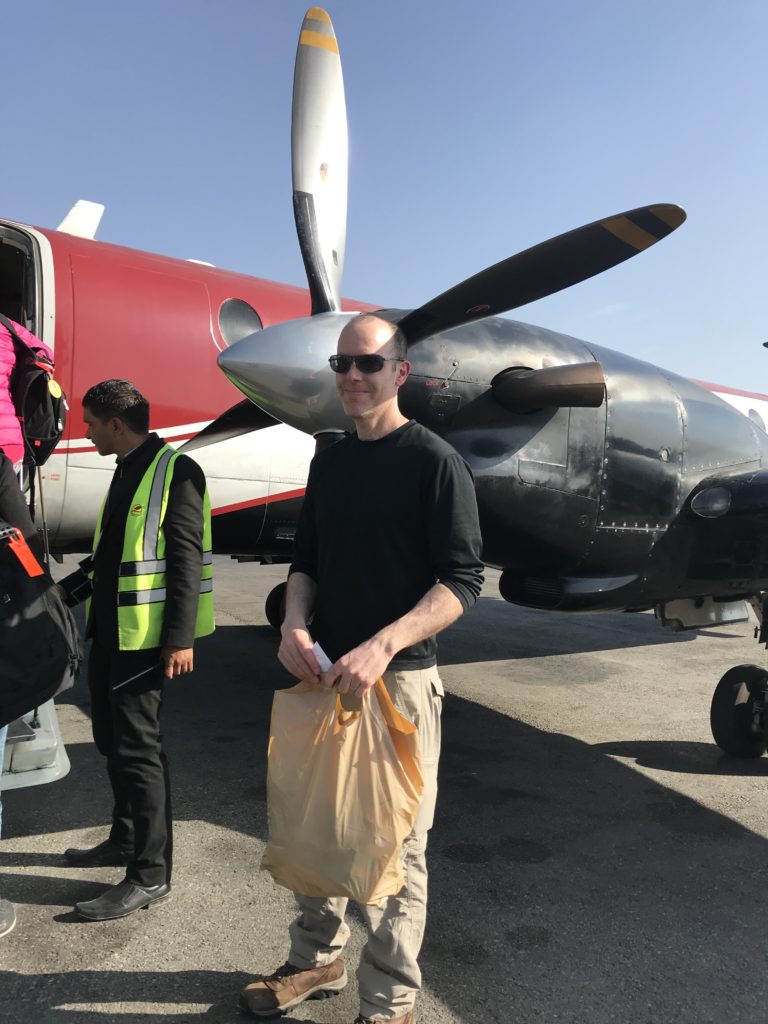
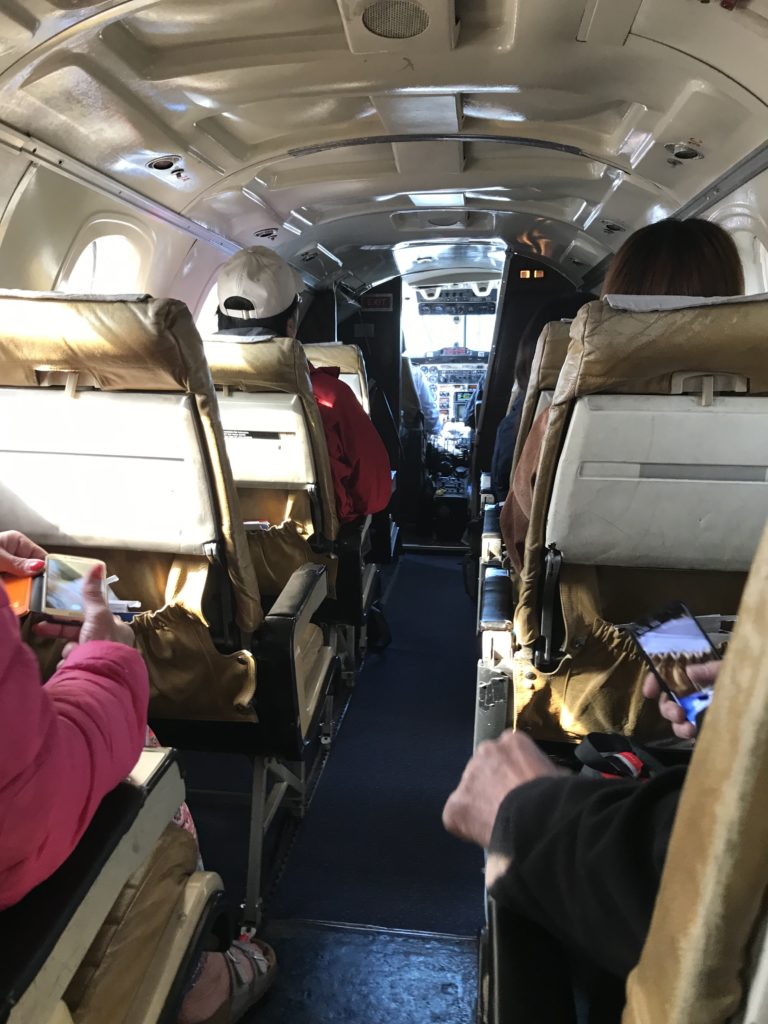
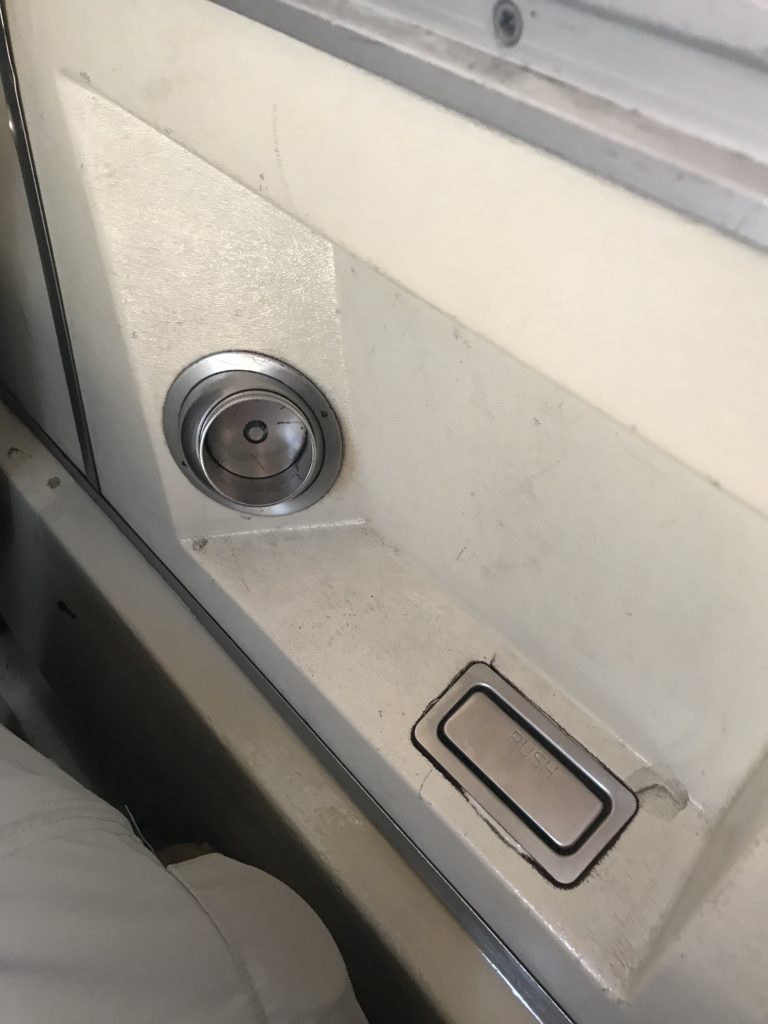
On takeoff, the pilot did the usual propeller plane parlor trick of applying the brakes, revving the engines, and then releasing the brakes so the plane shot down the runway with a nice pop. The 25-minute flight was flanked by the dry plains on the left and the snow-covered Himalayas on the right.
Down on the ground in Pokhara, I was picked up by a taxi and driven to my hotel where I met my Sherpa guide Lakpa. This easygoing, smiley chap of 43 has the distinction of successfully climbing Everest. I asked him if he’d like to go back to this peak and he quickly said no. He no longer does dicey mountain ascents and instead does trekking only. And I thought I was tough for climbing onto a roof to fix a shingle one time but apparently not.
The two of us walked along the edge of Phewa Lake over to a small restaurant patronized predominantly by locals. After eating, a Tibetan craft lady showed me her wares (that was not meant to be filthy) so I purchased several items for my people. As a gift, she tied a friendship bracelet to my wrist and to Lakpa’s wrist. The trek had not even begun and it was already wrought with awkward dangers.
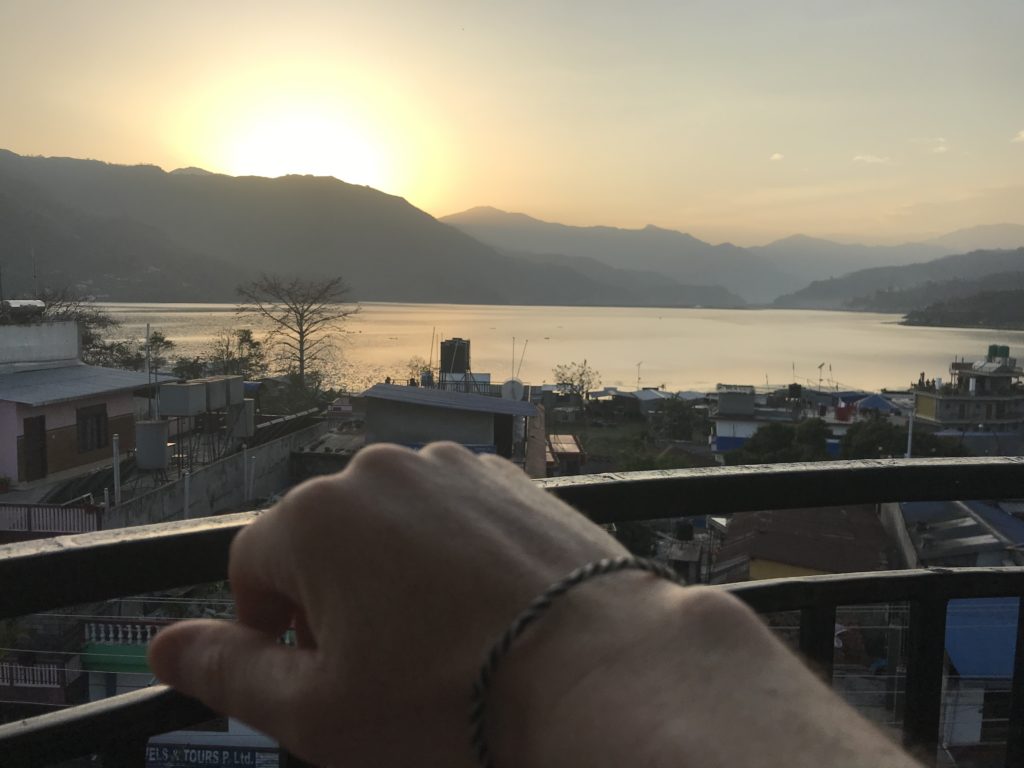
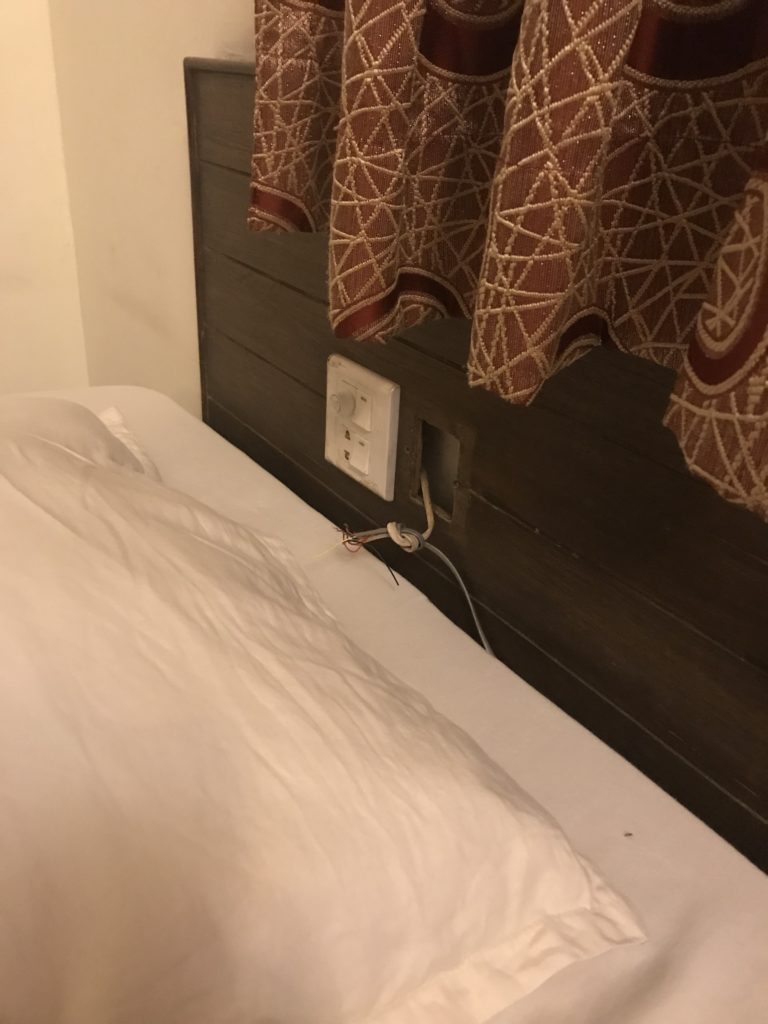
After waking at 5:30 AM, I got myself together and met Lakpa in the lobby. Our intent was to head to the airport and board another tiny and probably old plane and fly 25 minutes to Jomsom where our trek would begin. Flying to Jomsom is a bit squirrelly due to its robust elevation in the Himalayas. You can’t fly in or out of this mountain town after 10AM since after this time, almost every day, high winds arrive. If it happens to be windy before and up to 9AM, all flights will be cancelled. Today was such a day so we were forced to remain in Pokhara at least one more day. This was not the worst thing in the world since the weather in Jomsom was 32 degrees and snowing while Pokhara was a sunny, dry 75 degrees.
After a large meal, we walked down to the shore of Lake Phewa and rented a colorful wooden boat that we paddled around the lake for a few hours. I even swam in these fresh waters purely for good measure. On the opposite shore, we parked our boat next to a restaurant that commanded a sterling view of the lake and small city. Lakpa and I shared a beer and I asked him more about his successful Everest climb. He told me it took a few weeks to get to the top due to acclimatization issues that forced the party to go up and back down when someone developed altitude sickness. Lakpa said if it was just him and another Sherpa, they could have climbed Everest much more quickly.
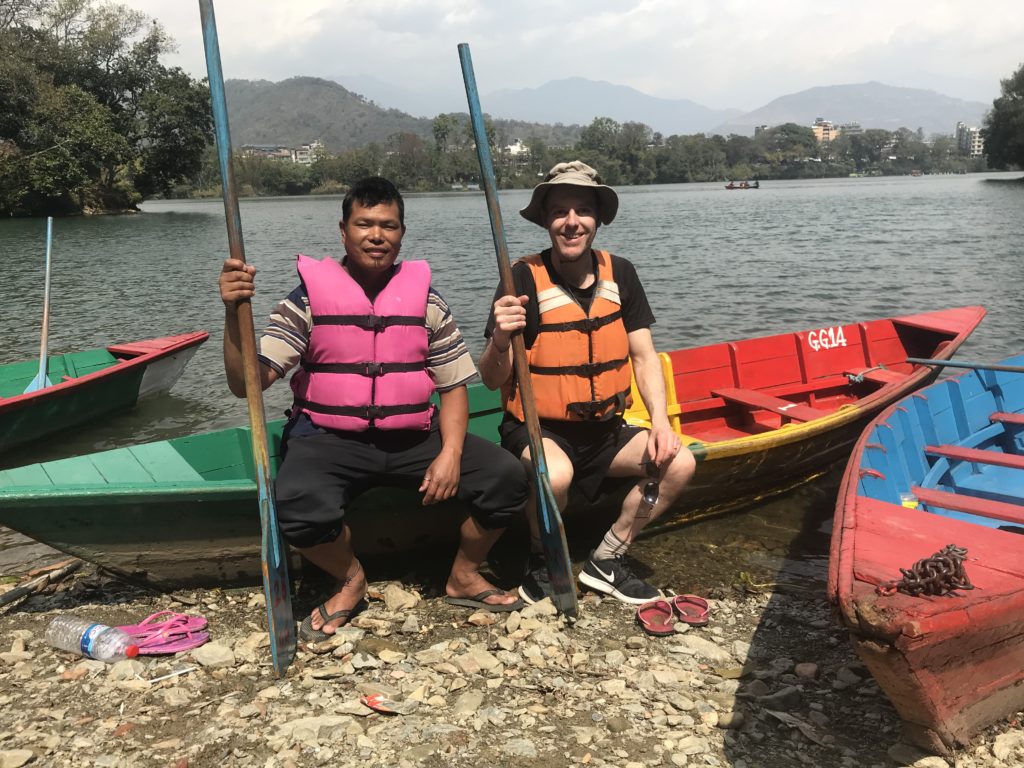
Lakpa then shared an amazing piece of information about his ancestry with me: the brother of his grandfather is none other than Tenzing Norgay. Along with Edmund Hillary, he was the first to officially climb Everest in 1953. I’m sure Lakpa’s Great Uncle was rolling in his grave as his Sherpa relative spent the day canoeing instead of trekking.
The next morning our flight to Jomson was again cancelled due to impudent weather conditions. Tomorrow will be the third time we drive down to the airport and attempt this flight. I tried to explain to Lakpa how this repetitive airport/flight cancellation business was like the movie Groundhog Day but this accurate reference fell upon deaf ears. In fact, Lakpa had no idea who Bill Murray was. Upon reflection, perhaps I could have likened our experience to a rejected narrative of HBO’s Westworld, a show where android hosts exist in various repetitive story lines in a large-scale amusement park for the enjoyment of the guests.
We have only been in Pokhara a couple days and have already racked up a large number of taxi rides due to the back and forth from the airport. I swear that each taxi we get in is smaller than the last.
Nothing to do with his lack of familiarity with Bill Murray, I told Lakpa I would enjoy having separate rooms (we shared a room the previous night and tentatively continued to do so going forward). I stressed the fact of how great of a roommate he was but it was the fact I had trouble sleeping through his snoring (he claimed to never snore which means his wife is extremely deaf or is extremely patient or sleeps in another room). His snoring at times had me thinking that someone was choking him to death. This was followed by a sound that resembled Darth Vader’s crippled breathing after he sustains heavy electrical damage from manhandling the Emperor at the end of Return of the Jedi. There may also have been a few rogue sleep farts but who the hell is keeping score in such matters? It would be monumentally hypocritical of me to complain about these nocturnal winds.
In any event, given all this, it was clear to me that all the friendship bracelets in the world could not keep us together as roommates.
With another pristine day in the mid 70’s, being in Pokhara was not the worst thing in the world. This time we decided to rent a couple bikes and cycle up 350 meters in elevation to the Shanti Stupa where we were furnished with varsity views pf Lake Phewa, Pokhara and the jacked Himalayas behind. Our ride took us through some mildly hectic, extremely non-touristy roadways. The way back proved to be busier with all kinds of vehicles beeping their way past us. My favorite was courageously entering a roundabout loaded with motorbikes, scooters, cars, and trucks. For fun, there were even a few cows walking against traffic in the middle of the roundabout.
Later on I saw a young cow lying in the middle of a very busy road with traffic buzzing by it in both directions. Cows seemed to walk aimlessly all over the country. Lakpa reminded me that due to the Nepalese belief that cows are sacred, they are rarely eaten here. Perhaps these dim animals are just bright enough to know this and feel empowered to the point of screwing with human transportation.

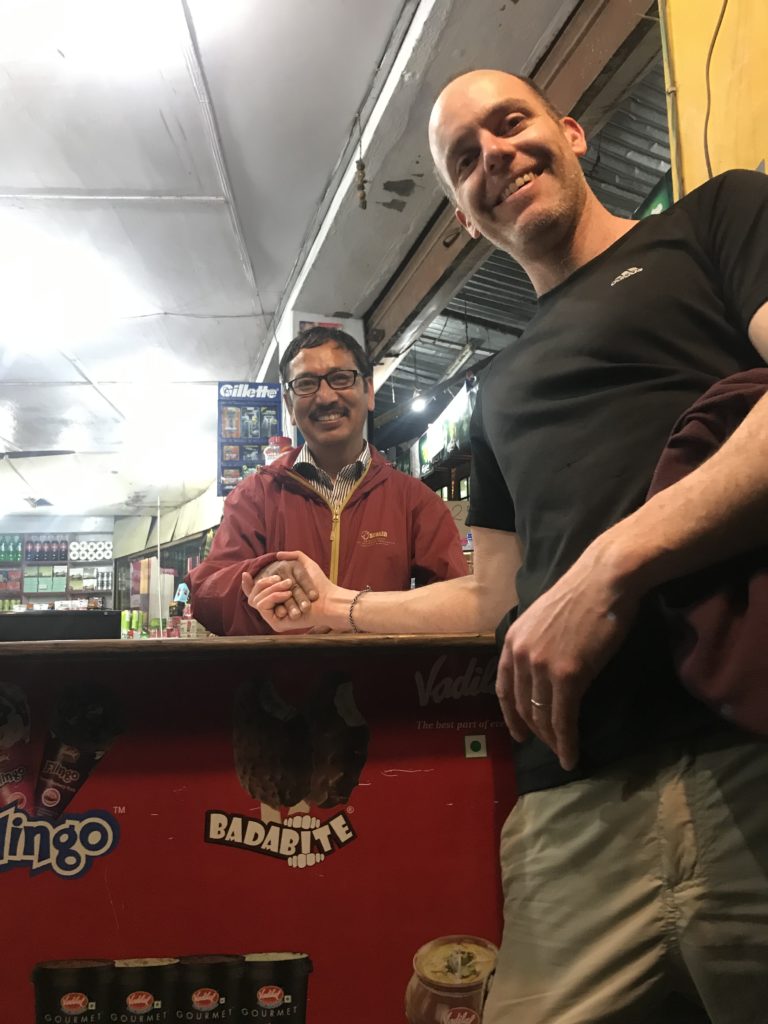
I would be remiss if I did not share two important observations with you:
1) Two or three years ago while in the Philippines, I suffered a rare moment of profound enlightenment. After losing sleep and hope to the sounds of so many barking dogs, I suddenly realized that my travels have taught me something unnervingly accurate: the more “worlds” your country has, the more barking dogs per capita will be found (see graph below that I drew while in Philippines). Nepal has supported this theory so strongly that I now believe it must be an “Eighth World” country. I know this is impossible since I believe that anything over a Third World does not exist. This means perhaps there is another factor at play that has escaped me. Regardless, I struggle to convey just how many dogs are barking in this country. And what makes it even more special is that many of these dogs love to save up the majority of their barking power for human sleeping hours. The hotel we stayed at last night, the New United Hotel, was perhaps the first night’s sleep not betrayed by this irritating chorus.

2) People love spitting here. I know spitting happens all over the world but here it nears being an institution. If spitting is sex, the courtship that precedes it would certainly be the loud hocking noise present in almost all spitting engagements here. You can hear the hocking start from far away. It is so passionate you are convinced this is the last spit that this person has been allowed to make. This may all sound a bit base but they somehow do it in a way that does not give off an air of poor manners. What’s more, they make every effort to spit in street gutters where no one will step.
The next morning I was up at 4AM. Today would be our third attempt at flying to Jomsom. We arrived at the airport before it opened so we waited outside the main gate. I foolishly set my bag down on top of a concrete barrier that was one of two that bordered each side of a short concrete bridge that spanned over a three-foot drainage gutter designed to divert a natural tiny stream. Either one of us bumped into the bag or gravity had its way for I soon found myself running down to the stream eight feet below where my bag was bathing. I then straddled the little stream like an aging gymnast and pulled my bag out. Fortunately I was able to get my clothes out and into Lakpa’s bag before anything got wet and as it turned out, the water was not as smelly and foul as I imagined. Feeling better about this mild annoyance, I went ahead and assumed my backpack was not marinated in fecal matter and yak urine and continued to use it.
The backpack gods may have been frowning on me this day but the deadly mountain flight gods were most certainly smiling. Our flight was finally clear to leave and 25 minutes after takeoff, we were gently landing in Jomson. Twenty-five minutes. The bus ride would have taken over ten brutal hours.
After eating breakfast at a charming restaurant, we walked three hours to Kagbeni where we stayed the night. Walking around this captivating little village, I noticed stacks of wood that lined the edges of the rooves on most of the houses. Lakpa confirmed that the wood was used as firewood but these piles served another purpose: they were also a sort of status symbol. A house with more wood on its roof is viewed as more prosperous.

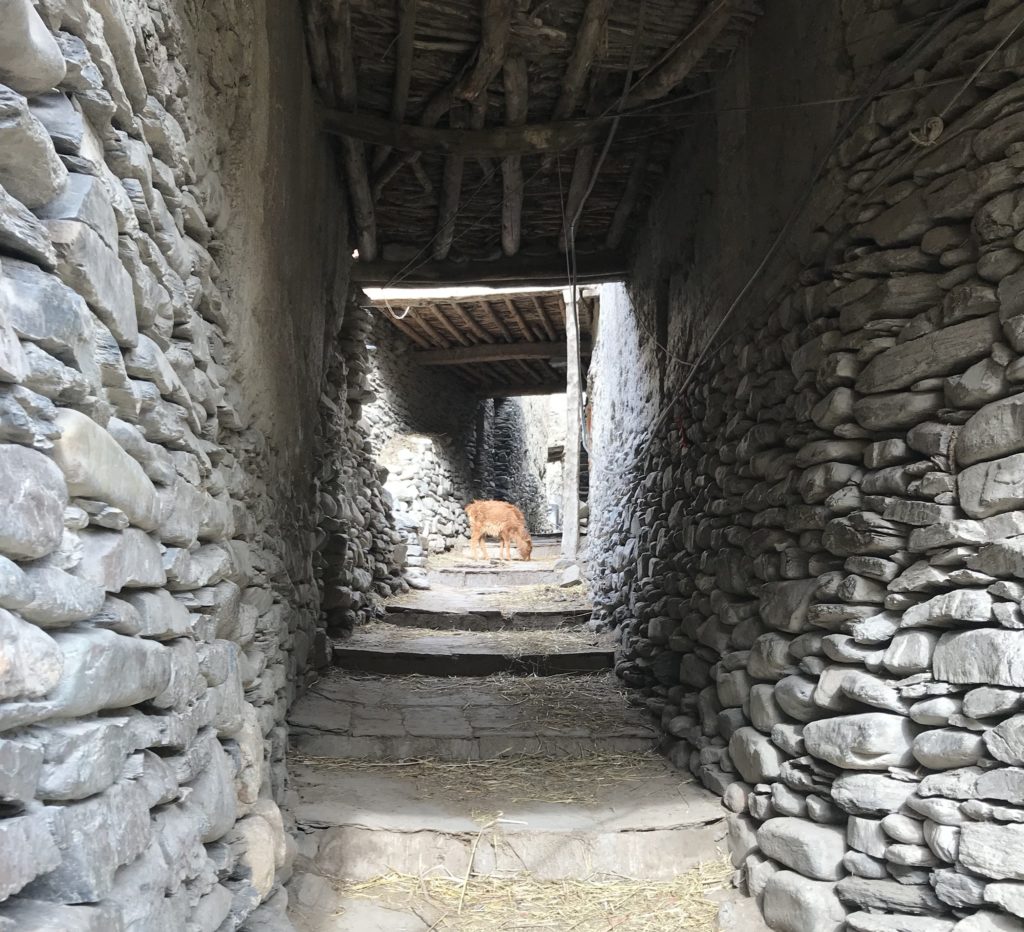
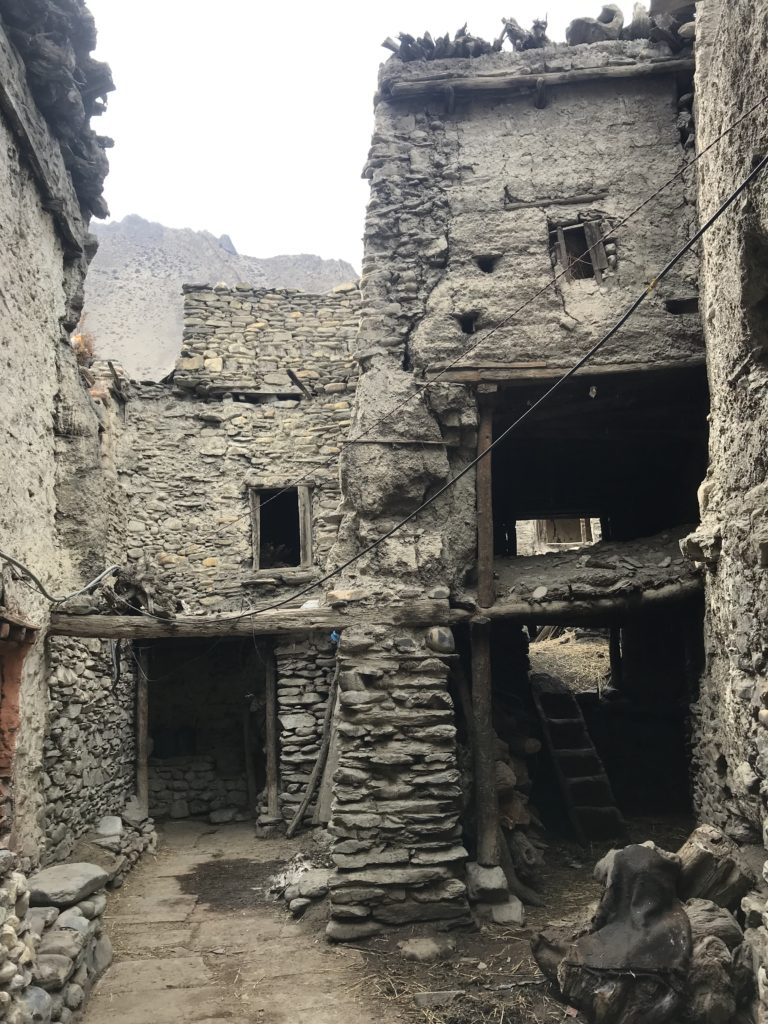
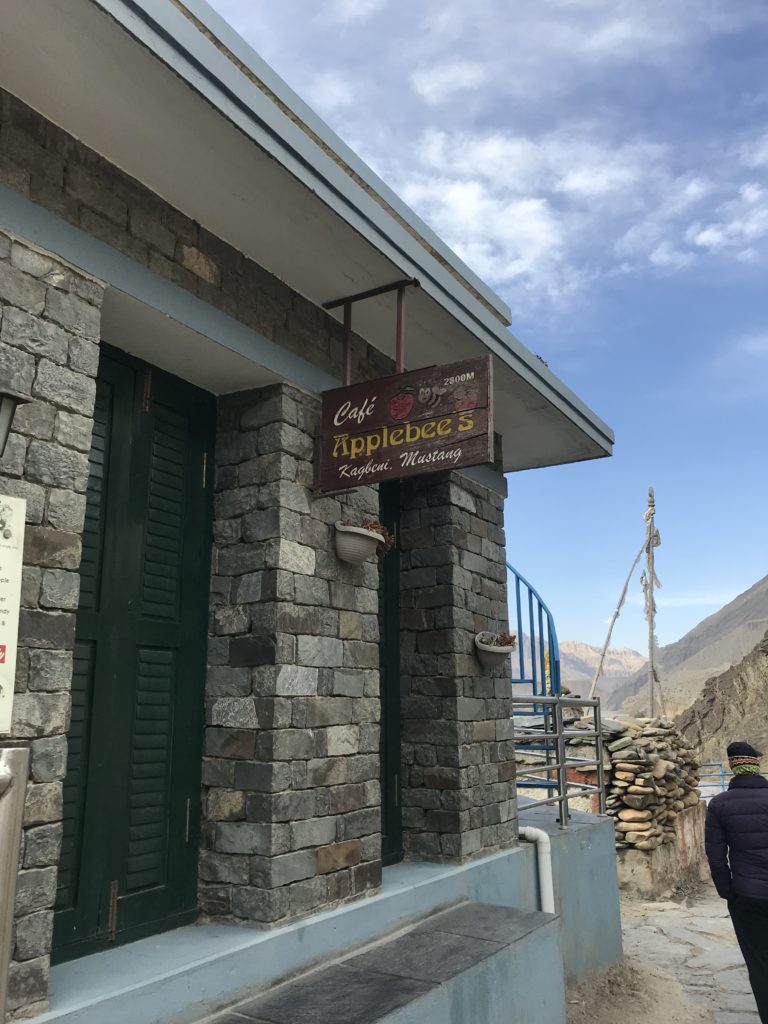
Yet again there was an abominable little shit of a dog that barked its way into my hate. The owners of our guest house lived across the slim street/path and had a dog that liked to go onto the roof and bark at every foreign organism that came within 60 feet of the house. Lucky for me, the height of the roof matched the height of my window exactly, allowing for maximum irritation when this little pube barked while I attempted to nap.
Before turning in, Lakpa came up with the good idea of simply moving to one of the rooms across the hall since it appeared we had the place to ourselves. Only one of the rooms was unlocked so I decided to make sure it wasn’t occupied. I looked inside and saw no belongings but there were lots of blankets spread out onto two small beds that had been pushed together. I vacillated for a while, wondering what I should do, even revisiting the room again around 8:30 PM to see if anything had changed. I looked again at all the blankets and thought they were using this room to store extra blankets. In the end, I decided to sleep in the Barking Dog Suite.
When I awoke the next morning and passed by the room in question, I spotted two sets of slippers just outside the door, one belonging to an adult and the other clearly to one of the small children. Basically, I almost fell asleep in the bed that was being used by a mother and her tiny daughter which is great when you consider the moment they would have opened the door to the compact room to find me be bundled up in my sleeping bag, passed out in their bed, most likely drooling a little bit.
On our way to Kagbeni yesterday, about two miles before, a cute little dog decided that Lakpa and I were his new friends. I told this dog he needed a friendship bracelet if he wanted to hang in our club. He followed us anyways. When we started on our way today, the cute little turd was waiting for us outside our guesthouse and continued to follow us on our way to Muktinath. He traced our steps for another two or three miles until we came to a suspension bridge. Although the pup probably could have made it over the bridge, he would not follow us. It was as if a spell was placed on him by some sort of municipal dog catcher wizard.
I felt bad for our little friend but shortly after crossing the bridge, we ran into about eight friendly Australian trekkers. I told them how we unwittingly abandoned our buddy and they instantly made sounds of sympathy. I was happy to see these lads show their canine affection once they crossed the bridge back to where we left little guy.
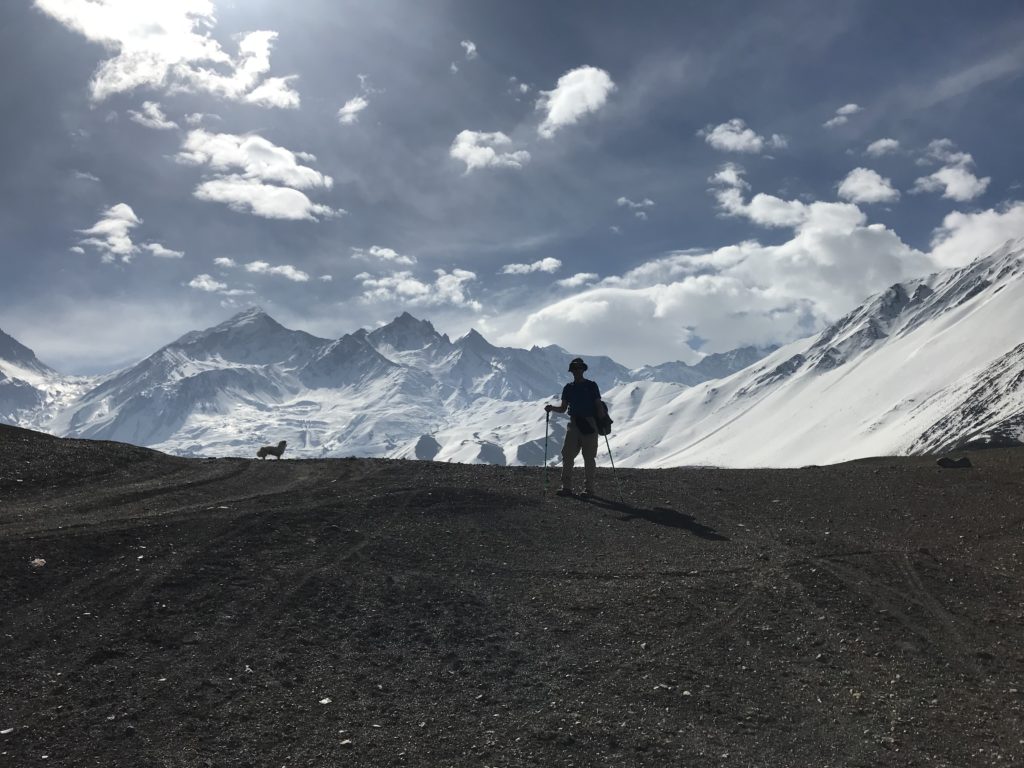

As we ascended, I could feel the altitude in the way I would feel the one cigarette a year I used to smoke. Kagbeni was about 3300 meters and now we topped out at about 4000 meters which is probably the highest land elevation I have achieved in my mildly adventurous lifetime. As far as I know, this will be the highest elevation realized on this trip.
Muktinath, with its dirty roads almost has the feel of a town out of the old West, something like the town in Clint Eastwood’s Pale Rider. Now place this town in the Himalayas, swap the horses for ponies and donkeys, string up some rudimentary power lines, and allow the buildings to be adorned in a semi-planned Nepalese style.
As with our Kagbeni guesthouse, Lakpa knew the owner of Caravan Hotel in Muktinath. Like all the other guesthouses I’ve seen up here, this place had rough wooden floors, stucco walls and exposed wooden ceilings. The stairways in all of these houses are guaranteed to provide vertigo. Each house also seems to be furnished with a chief lady. She shouts orders and always maintains a volume higher than the rest.
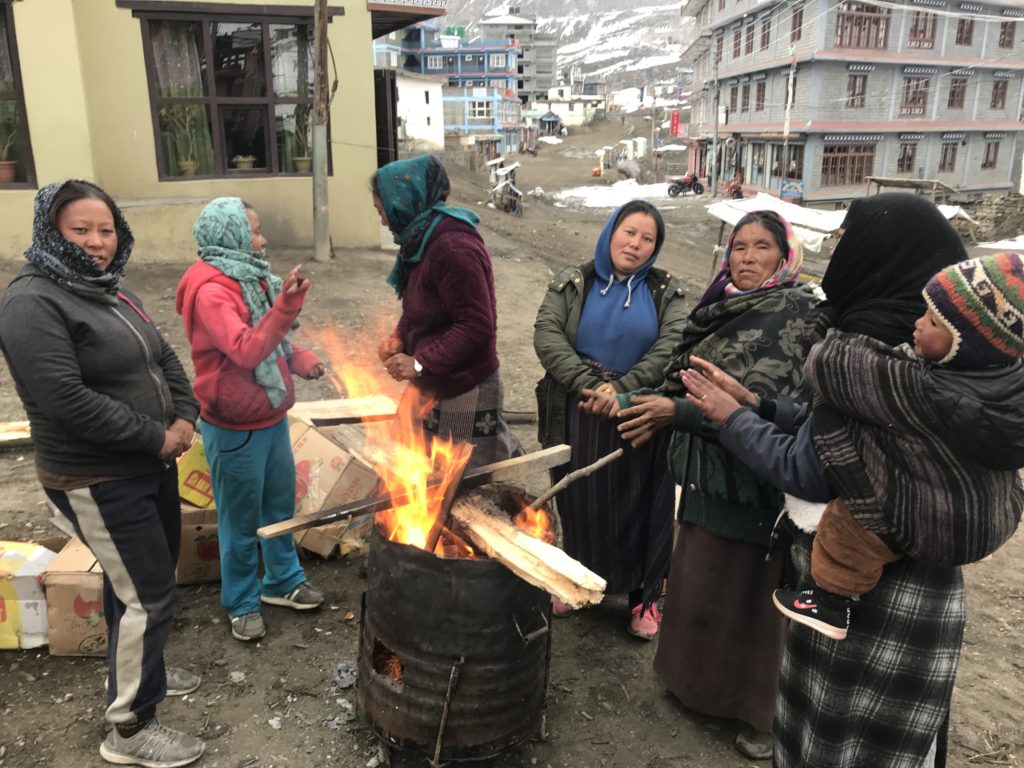
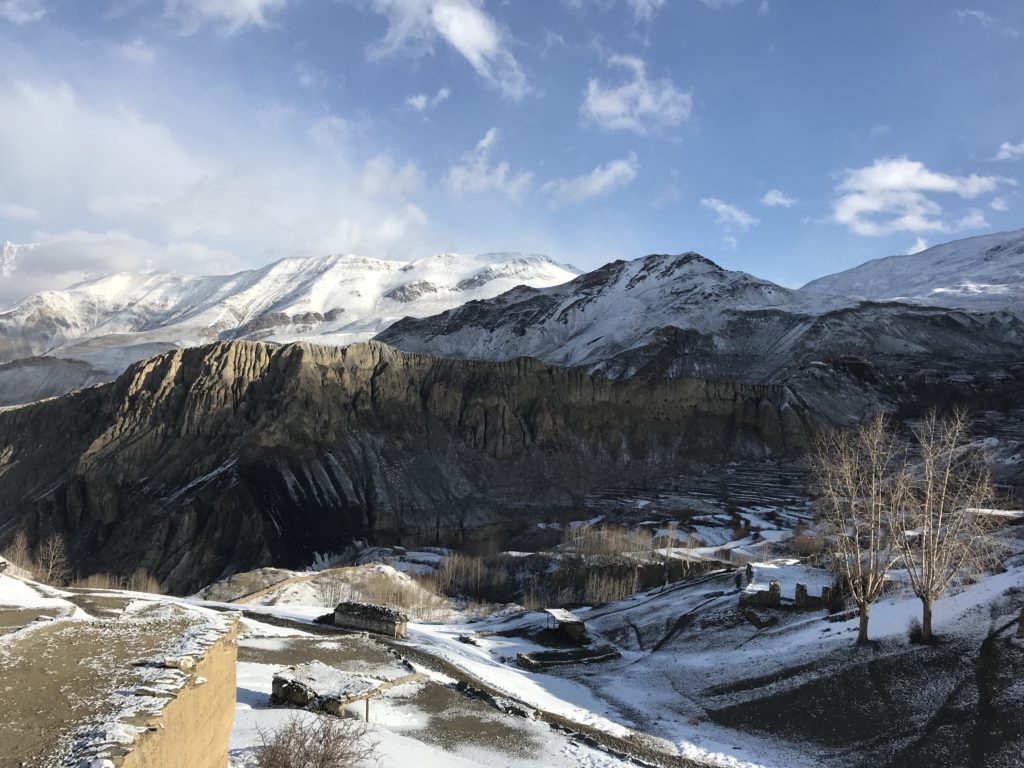
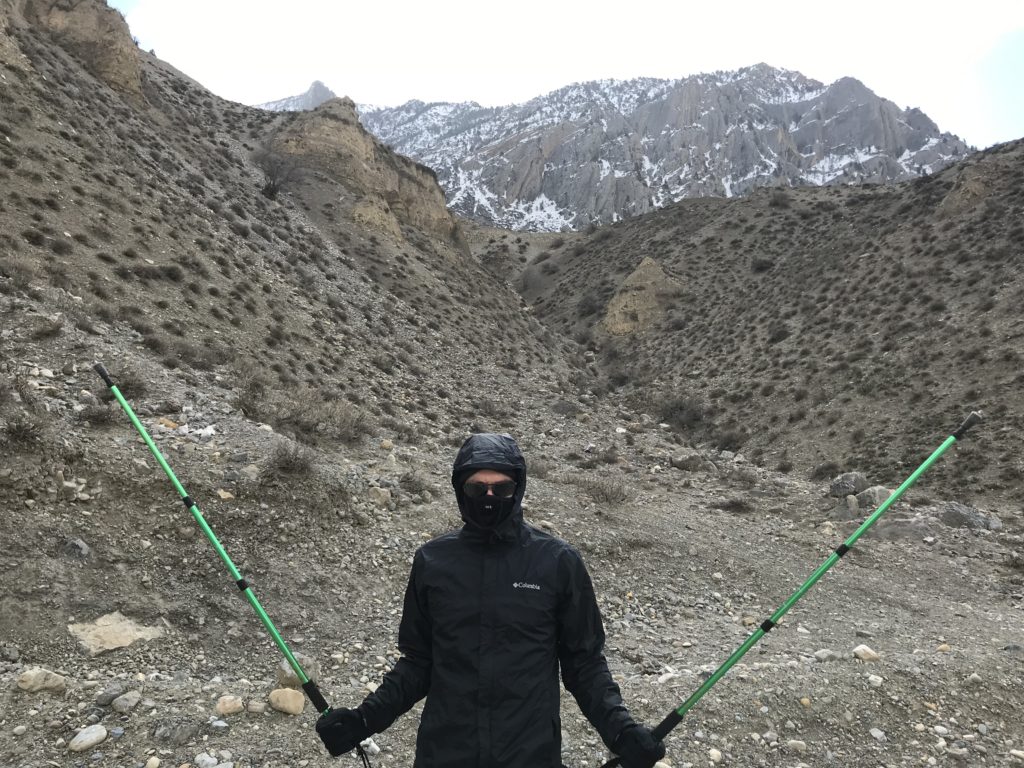
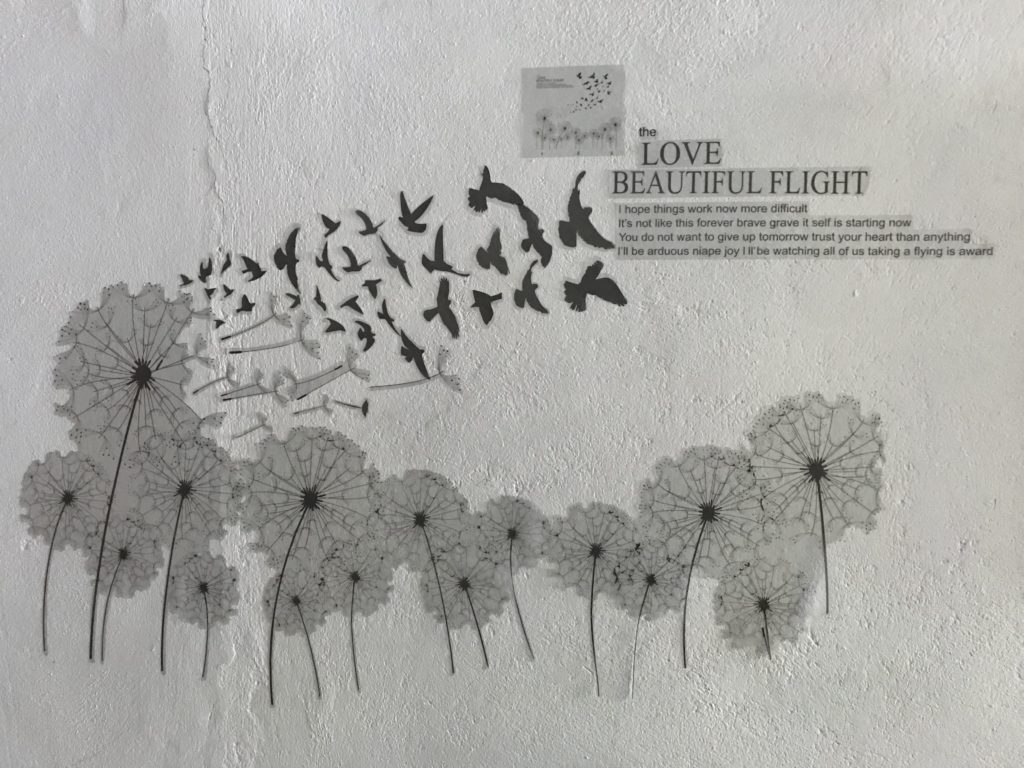
The guest houses appear to be hundreds of years old but in fact are only a few decades old or less. Perhaps levels and tape measure are hard to come by in these parts but the concepts of “level”, “plumb”, and “square” are not to be savored here, giving the look of an extremely haunted structure. Most of the windows are so out of square that the wind joyfully continues its journey right into your bedroom as you try to sleep on a 20-degree Fahrenheit night.
I can’t stress enough just how insane the clearing-of-the-throat-into-spitting is. It is quite literally a part of life here so fundamental that it must be tied to their survival in some way. When I am walking down the street, the greatest interval of time between one person hock-spitting and the next has probably been around 52 seconds.
Also of note is that even though the temperature is below freezing at night and not much above that during the day, the front door will be left open for about 18 hours a day. Perhaps I mentioned that none of these buildings have heat? This causes me to leave my winter coat and hat on while inside and at night, I zip myself up in my -20-degree Fahrenheit sleeping bag and pray for dawn.
This morning provides yet a third ingredient to my mountain travels. Flying up here three days ago, I had no appreciation just how arduous the 10-hour bus ride from Pokhara to Jomsom is. My 25-minute flight completely glossed over the primitive, bruising nature of ground transportation here. The roads are so bad that I can’t tell if they are slowly being built or slowly being destroyed. Landslides seem to be winning the battle for space on these roads.
As we were following the river valley slowly down towards Pokhara, the bus frequently drives on either side of the river. Being from the US, I would envision a bridge to achieve the crossing of a wide rocky area of multiple shallow rivers but no, there are no bridges; here the rugged looking bus plows through the water. I assume and pray the driver is intimate enough with these river depths. Progress is slow as the vehicle cautiously negotiates exciting dips and impolite holes, bottoming out at times and rudely throwing anyone in the back seats into the air.
As I write, the bus has had to pull over and wait a couple hours or more as construction vehicles block off the road for four-hour shifts so they can painstakingly clear and reshape the road after a major rockslide (this writing session happens roadside since any attempt to write onboard results in something similar to baby’s first drawing).
Yesterday, as Lakpa and I walked along a road to Jomsom, there was a constant trickle of small stones and dirt that had formed a massive pile that was in the process of slowly creeping out into the road. Lakpa said there would probably be a landslide here during the monsoon season. This spot was one of an innumerable amount along the road. Dangerous chunks of boulders, dirt, and trees hung over us on much of our journey. It made me respect the absurd amount of time and resources needed to not just build a mountain road but to maintain it.
While not busy having my spinal discs sadistically crushed on this bumpy bus ride, I had a wonderful conversation with a pleasant Indian gentleman of 65 named Rajesh. Like so many Indians travelling in the area, he had made a pilgrimage to Muktinath, home of a sacred Hindu site and temple. Hindus come to Muktinath to pray for passed loved ones and to collect special black rocks at the confluence of two mountain rivers. Before explaining this, Rajesh spent the first 30 minutes of our conversation to explain the many relatives he has that have lived in the US since the 1960’s. The details of their professional successes and domestic minutiae represented a load of data impossible for me to pass on to you. Sorry. From what I have seen here, Indians take great pride and pleasure telling you of the great accomplishments of their relations. I have yet to hear about any Indian black sheep family members.
Rajesh was also pleased to report to me the total cost for a six-week European tour that he and his six relatives recently completed. The total sum of all travel expenses was $19,000. While this impressed me, I was equally impressed that Rajesh took the time to tally the final travel cost for his seven-person party.
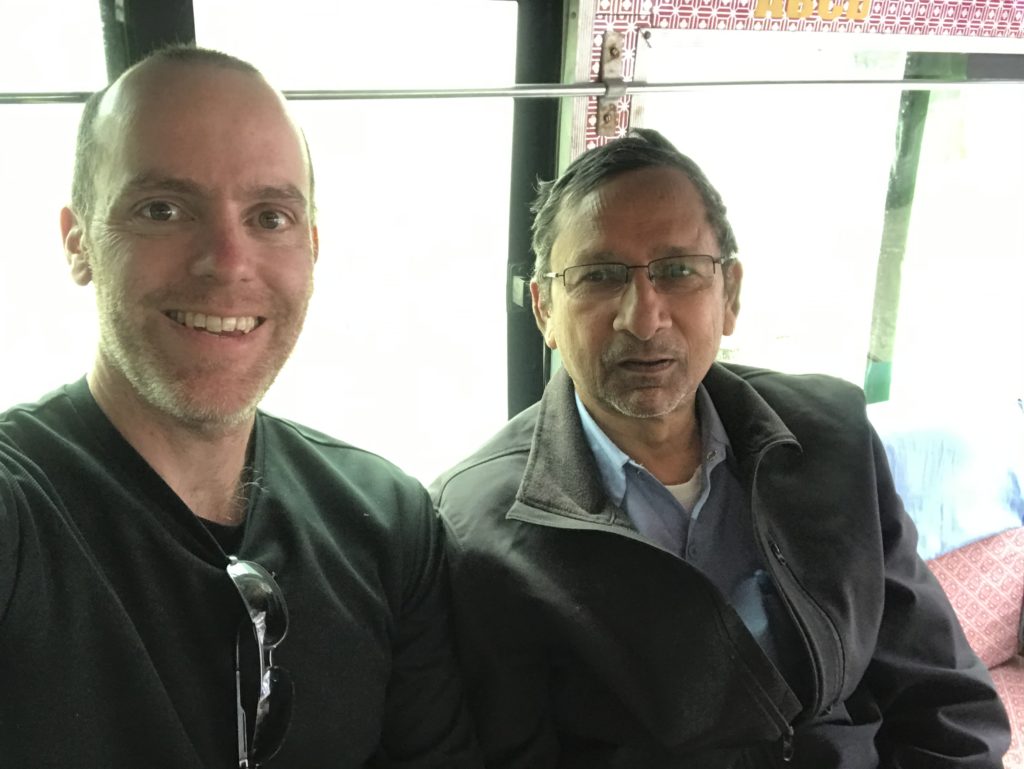
Lakpa has just told me that this part of the road, from Muktinath down to Beni (about 60 miles) is only ten years old. What this means is that before this road, only ten years ago, all vehicles had to stop at Beni and unload all supplies and people. From there, people had to walk 60 miles through the mountains to get to Muktinath (unless they had money enough to fly to Jomsom and then walk five to seven hours to Muktinath). Like all the supplies, they could also hop on the thousands of donkeys making the trip up. Although Jomsom could take in some supplies, this area still had depended largely on donkeys and human porters to bring supplies to them.
The apocalyptic bus ride came to an end for us in Tatopani. After dropping my things at the hotel, I walked over to the hot springs and soaked my frightened figure into a burning stew for a while. When I rose from the water, I gathered my things off a rock wall by some older Nepalese ladies that were preparing to enter the spring. One of them was incredibly sassy and upon seeing my uncovered body, she smiled devilishly and shouted many Nepalese words my way. All I could do was point to myself and proudly say, “Yeti!”, hoping she had mistaken me for the mythological furry creature supposedly roaming the Himalayas.
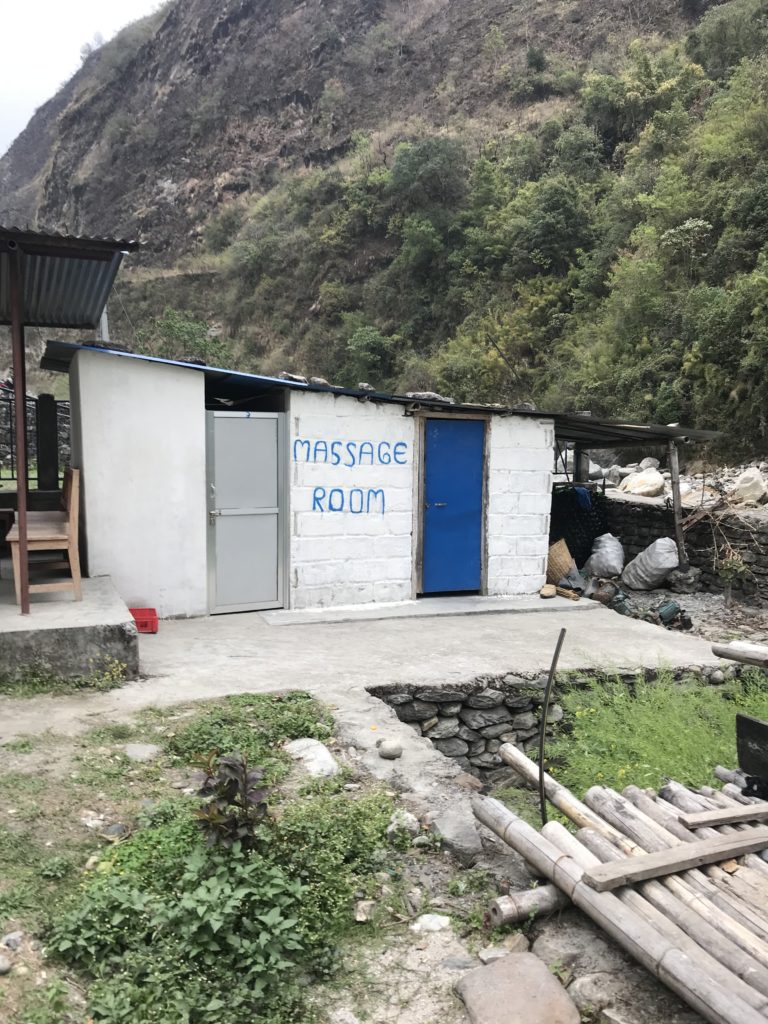
Seen on the grounds of the hot springs. In this case, “Massage Room” is Nepalese for “We take your western genitals and sell to Himalayan witch”.
Later that night, I visited a small craft shop right next to our guest house. The tidy shop was piloted by a pleasant Tibetan lady. Having a fine hold of the English language, Tsering and I were able to have a robust conversation. Although Tibetan, Tsering has never seen Tibet. She was born in a refugee camp in Pokhara where she still lives with her siblings and brother when not in Tatopani. Her mother arrived to the camp at the age of one, trying to escape the aggressive Chinese Communist regime. Although her life seems to be simple and happy, Tsering informed me that growing up in a refugee camp was no pleasure cruise. She did extend an offer of having one of her family members show me the camp when I returned to Pokhara but with my short stopover, I did not make it happen which a large part of me regrets.
The next day I gobbled a couple pills in effort to curb the pain and inflammation of my right knee. Luckily, it was enough to allow me to make the six-mile, 900 meter rise to Shikha. We passed through dozens of terraced farm villages that were immersed in the ways of spring. I noticed these lower mountains were more populated by both humans and plants than the Mustang District we just came from.
Rhododendron trees were in full bloom, their brilliant red colors only challenged by that of the colors of the ancient Hindu Holi festival being celebrated in every village we passed through. Powders of all colors were on the ground and faces of many of the villagers. The festival seems to have a broad purpose but it does celebrate love in the general sense, the arrival of spring, and a good spring harvest. Water fights also factor into this festival for some reason. As I write, the local residents are screaming at the tops of their lungs, throwing water balloons and dousing each other with water any way they can. At an earlier village, a little boy stood crying because he got soaked by someone. About eight other people stood around the boy laughing as he cried, hopefully a good character-building experience for the young man.
Adding to the color was a 70-year old Chinese man who was a trekking beast. He claimed to have done a very challenging 5000 plus meter hike up a nearby mountain pass. It was easy to see he spent a lot of time outside in the sun trekking since it looked like he stuck his face into an oven every day for 20 minutes.
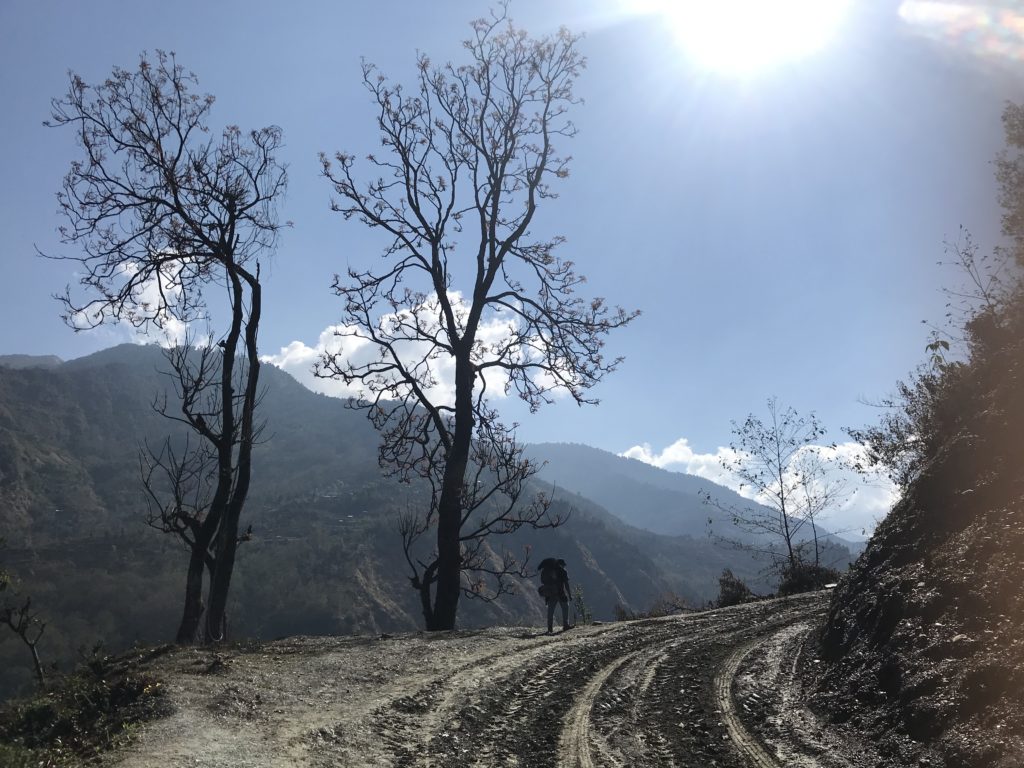
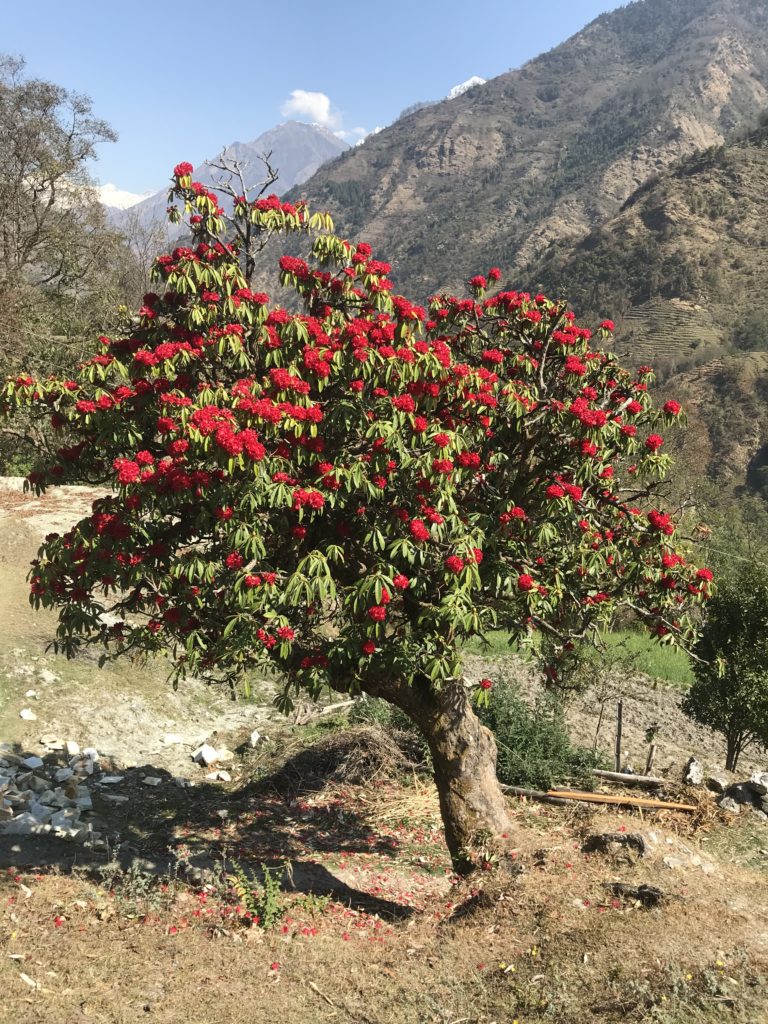
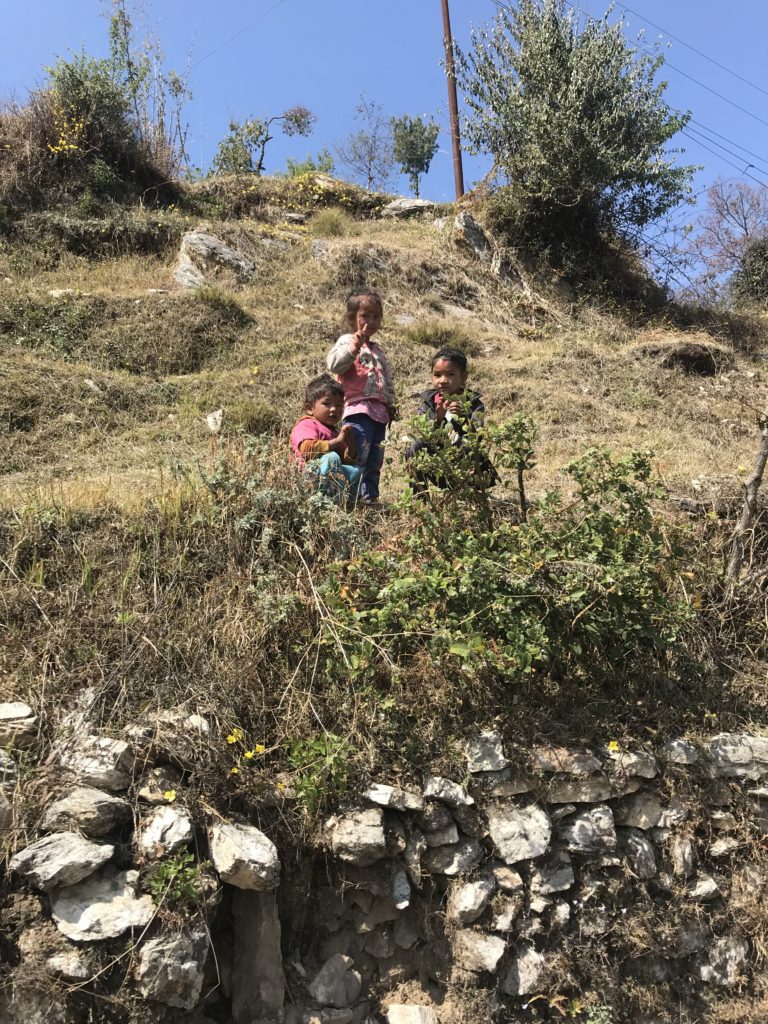
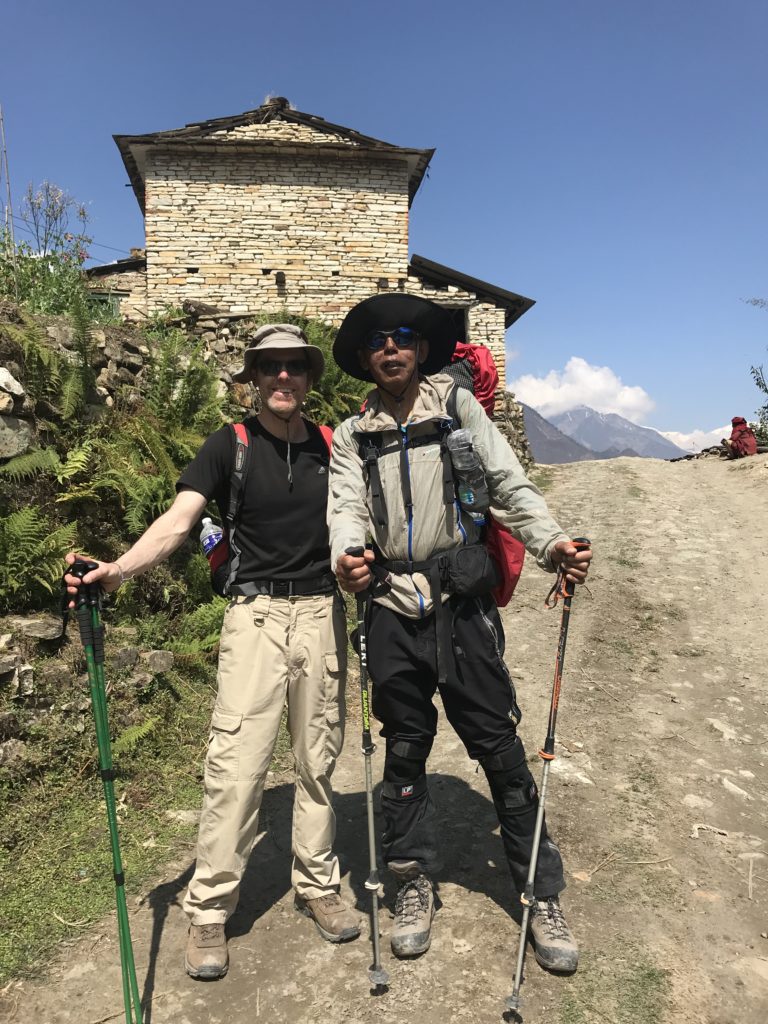
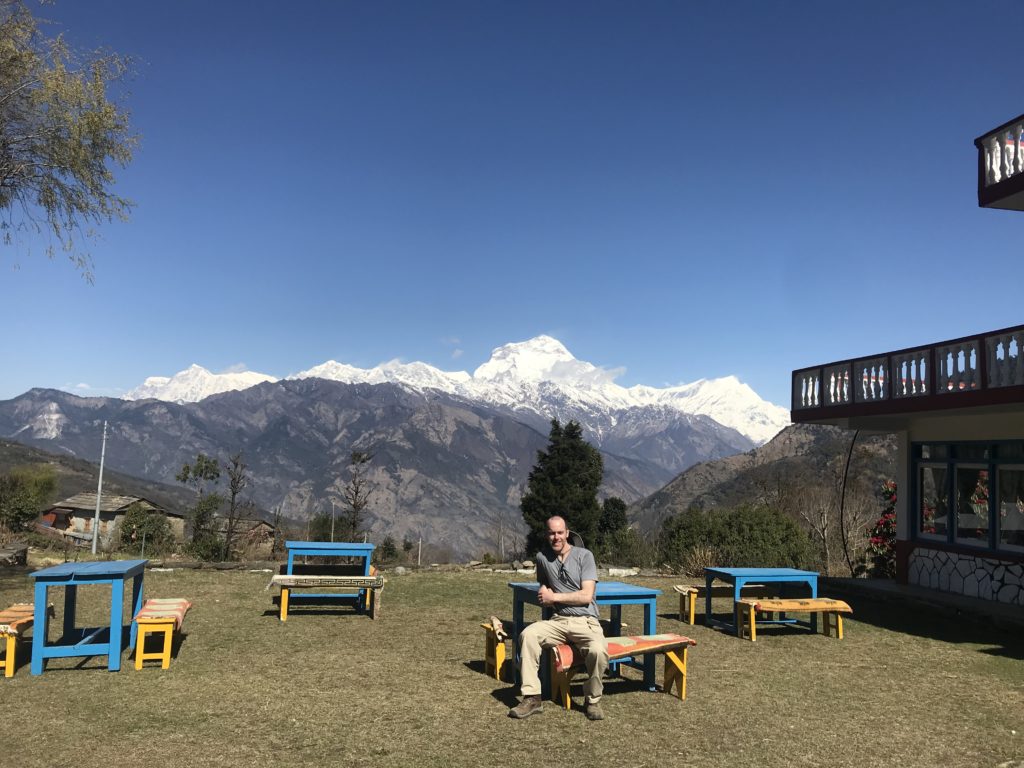
Taken from the “About” section of www.HimalayanBlueTablesYellowBenches.com: “When Owner and CEO Chris Coxen was nine years old, he had a dream about making blue tables and yellow benches in the Himalayas. Thirty years later, after unhappily making a lot of money in the US stock market, Chris decided to put this young boy’s dream to the test. Although everybody said he was crazy, Chris has proven them all wrong: only six years after the firm’s inception, Himalayan Blue Tables Yellow Benches has become the number one provider of blue tables and yellow benches in the Himalayas.”
I have ordered dumplings eight or so times since coming to Nepal and every time, there are exactly ten dumplings in an order. I am fascinated how this dumpling code is adhered to no matter where I am in this country. My fascination only grows when I then reflect on how the structures in Nepal might look if they were as committed to a building code as they are to their dumpling code.
This morning we woke in Ghorepani at 4:15 AM and hiked up another 350 meters to the summit of Poon Hill, giving us an elevation of about 3200 meters. It was completely dark except for the near full moon and once on top, there were eventually 150 or so other people who came to watch the sunrise. People have been climbing up to this spot for years to watch the sun rise due to the incredible and expansive mountain view that could only be captured with the “pano” option on a camera.
It was below freezing so everyone was wearing warm clothing except one odd fellow with a shaved head that had no hat or gloves on. He wore only a thin shirt. As everyone else laughed, conversed, and took pictures; this slim chap that almost looked like a Buddhist monk was sitting cross legged on a stone wall doing Tai Chi or some similar discipline as the rising sun shone on him poetically. What makes this really special is that he smoked a cigarette while practicing this ancient art.
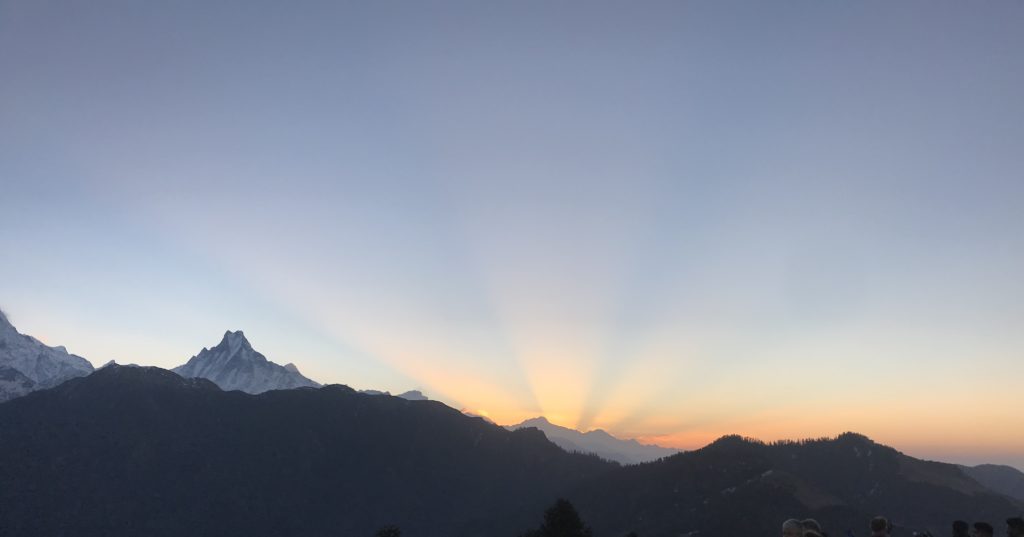

The past couple of days of trekking were not being polite on my knees and the over 2000-meter descent today was not what the doctor ordered. Over half of this descent was more or less one giant staircase down.
Since Tatopani, the trail was often a seven-foot wide stone path that winded through villages, a path that was often filled with chickens, horses, donkeys, and buffalo. Buffaloes are usually calm but Lakpa informed me that he has been attacked by them a few times. But the story he told me that really blew my mind was how many years ago, an ox attacked him and threw him down a steep 100-meter hill. Badly banged up and furious, he dragged himself back up to where the ox was, threw a large rock at the ox, stunning it and then pushed the big beast over the edge of the same 100-meter hill, killing it. This is my kind of Sherpa.
After many hours, we finally reached the small town of Hille. Our rustic digs for the night was Green View Hotel, a guest house riddled with poor craftsmanship but how can I even complain when they charge $4.50 a night for a room, a fascinating price for a room especially when you consider that the price of a beer at this guest house is $5.50.
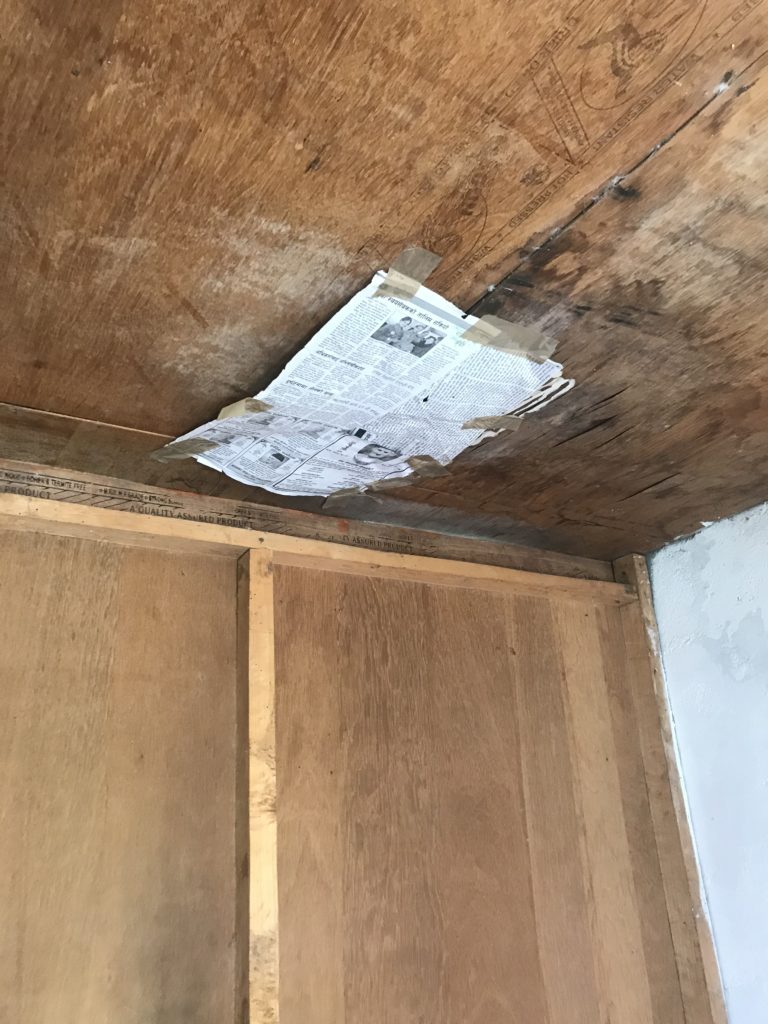
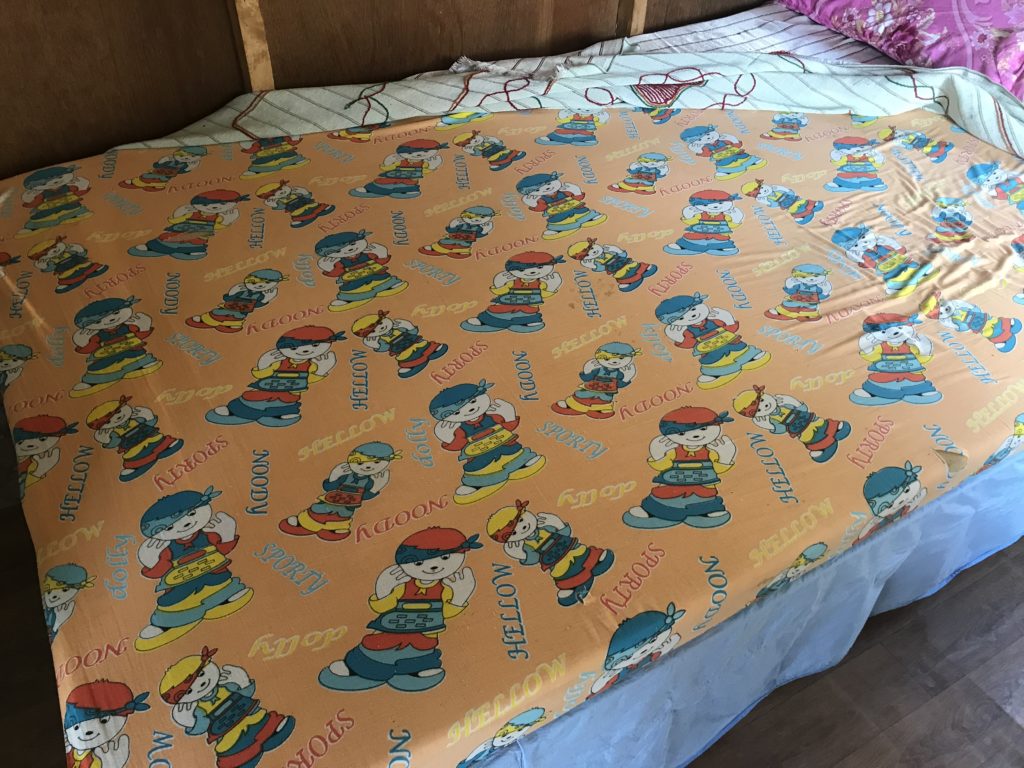
Via two hours of walking and a comical two-hour cab ride in a beat up old little Indian-made economy car along desperate, dusty roads, we arrived back Pokhara. We visited our favorite little restaurant, Himalayan Cuisine and then paddled through the lake again. Everyone in the boats and along the shore was in a festive mood on this sunny, 80-degree day.
The next morning, Lakpa and I boarded a bus bound for Kathmandu. Lakpa took the bus to the final destination while I got off about halfway to embark on a river rafting tour and then on to a jungle safari in Chitwan. The bus took us through the usual scenes of hectic third world life. Old ladies swept, young nice punks looked at their phones, dogs slept, horns honked, children played, and unattended trash fires burned. In the seat in front of me a young American man and woman in their early 20’s spoke in young fresh tones. They seemed to be part of a group whose purpose I was not able to determine. The chatty young man seemed bent on winning the affections of the quieter, more reserved kitty.
The exchange between them at first seemed sweet but with a light shade of desperation. At first, he showered her with all of his knowledge and experience of mountaineering. Later on he realized the wise move was to choose a topic that she had more intimacy with. Once he introduced rock climbing to the conversation, she opened up and her personality blossomed like a spring flower. I was a whisker away from launching into a very calm, serene David Attenborough narration of this young, tender mating scene taking place in the back seat jungle of this Nepalese bus.
With no warning the bus pulled over to the side of the road and people started shouting at me to get off. I guess this was my stop? I hastily pulled my things off the shelf and scrambled down the aisle. I’m almost certain I hit a couple people in the head with my trekking poles.
I made a quick sloppy goodbye to Lakpa and told him we should try to meet in Kathmandu later that week. Before I knew what was happening, I found myself floating on a raft down the Trishuli River, seated across from a more or less socially awkward 62-year old man that looked like Sean Connery after four months of a high carb diet. Victor was his name and he was from Latvia. He seemed unable to find conversational comfort with the other Nepalese and Indian tourists on the two rafts so I did my best to speak with him often. Something about Victor made me think he was a pickpocket’s dream no matter where he went. Although relatively well travelled, he had this slight mad scientist, math club champion, isolated way about him that made me wonder how he survived alone in such a foreign environment.
After rafting, one of the guides led us back up to the main road and told us to sit at a table while he waved down our buses. The tiny little area we waited at was perhaps some accidental rest stop combined with a micro village. The table we sat at was partially occupied by a young woman looking at her phone and conservatively speaking, about 100 flies. Underneath by my feet, a chicken loitered. At one end of the table, about a couple feet in the air, a sleeping baby in a semi-transparent red cloth hammock hung from the roof that covered the small area. Logic told me the baby belonged to the young woman but at one point, she got up and left so I have no idea who this sleeping baby belonged to.
In the middle of the open area that was surrounded by a sheep and several structures, was a man squatting over a power saw who was in the process of cutting up about 50 twenty-foot lengths of metal rods into shorter lengths. His work created a powerful performance of shrieking sound and sparks that somehow did not wake the sleeping baby only 20 feet away. But then again, this baby slept only 25 feet away from a non-stop parade of loud honking buses, trucks, cars, and motorbikes. The whole scene was wonderfully chaotic and made me feel like I was somehow temporarily trapped inside Victor’s mind.
At that moment, a small local bus pulled over and the rafting guide waved Victor over. In a mildly confused state, he awkwardly steered his large figure into a bus packed with Nepalese. The bus door closed and it was as if the bus and the crowd inside swallowed him whole. As the bus drove off, I couldn’t help but think, “…and that was the last that anyone heard or saw of Victor the Latvian.”
My bus was waved down soon after and I had to jog down the road to reach it while it waited on the side of the road and caused a low level of irritation to passing traffic. I took a seat in the sparsely populated bus and watched/listened to Nepalese music videos that were blasted from the vehicle’s sound system. Yet again the bus stopped abruptly and I was rushed off and into a private taxi that dropped me at my hotel near Chitwan National Park.
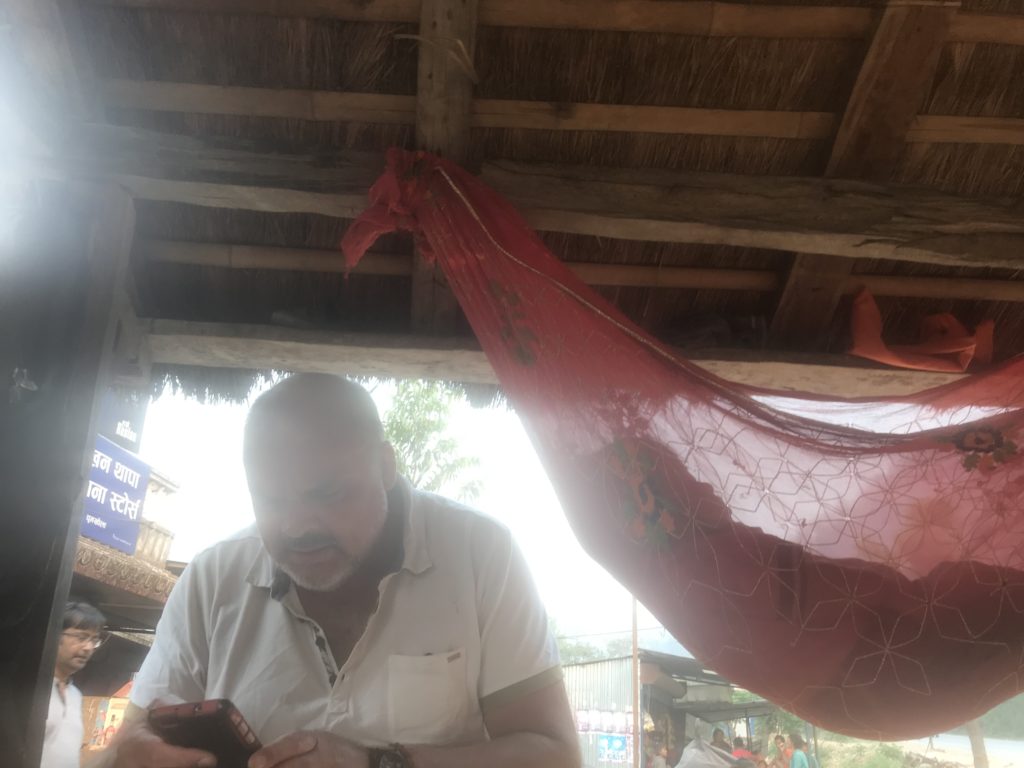
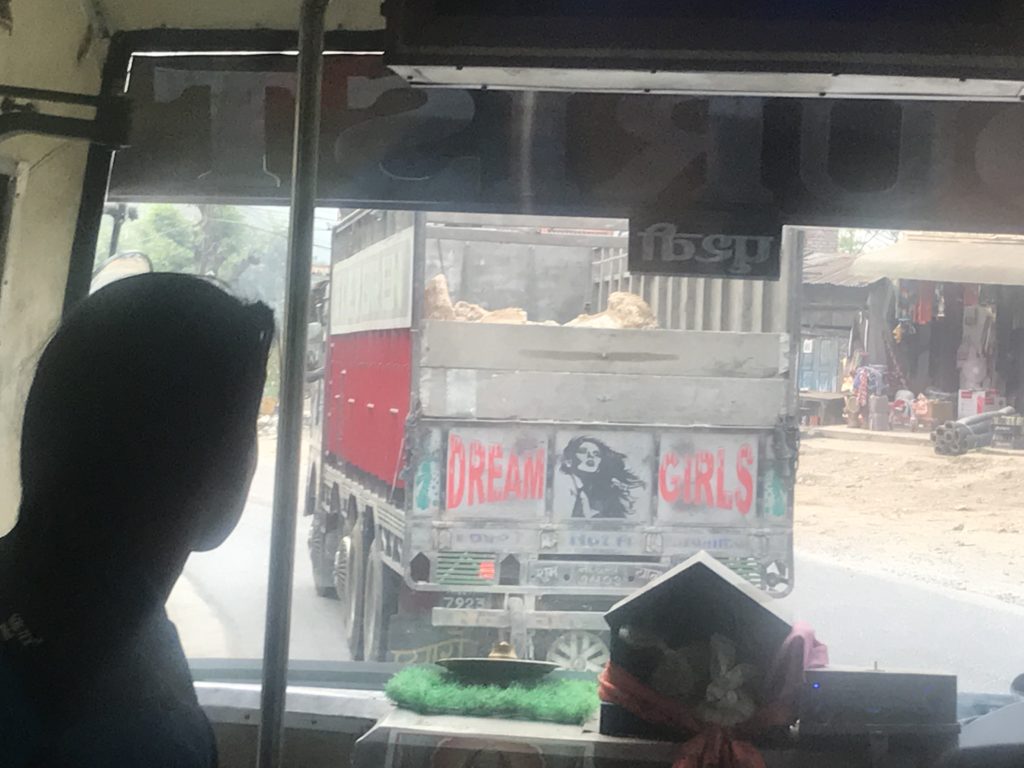
Employed by the hotel, our safari guide Suroz (I’m probably spelling that wrong) was top notch. Before the government moved all houses and hotels out of the official park area, Suroz grew up in a house in the park. With his camouflage hat, binoculars, square jaw, sharp nose, and eyes that would have made an eagle envious, he looked like an intense, taciturn, confident Indian colonel in the midst of a military campaign. The way he constantly scanned the horizon and identified animals no matter how distant was legendary.
He was always on, always alert. Before the safari started, I saw him standing on some steps that opened up to the 5000 square foot courtyard on the hotel grounds that contained some trees and flowers. Seeing something of interest in the small confines of this space, maybe 40 feet away, he decided that binoculars were necessary and meticulously raised them to his eyes, inadvertently giving birth to a humorous moment. One of the few times over the three days I saw his serious veneer compromised was when we spotted a sloth bear on a few separate occasions in the park. For a brief spell, he became childlike, unable to contain his joy.
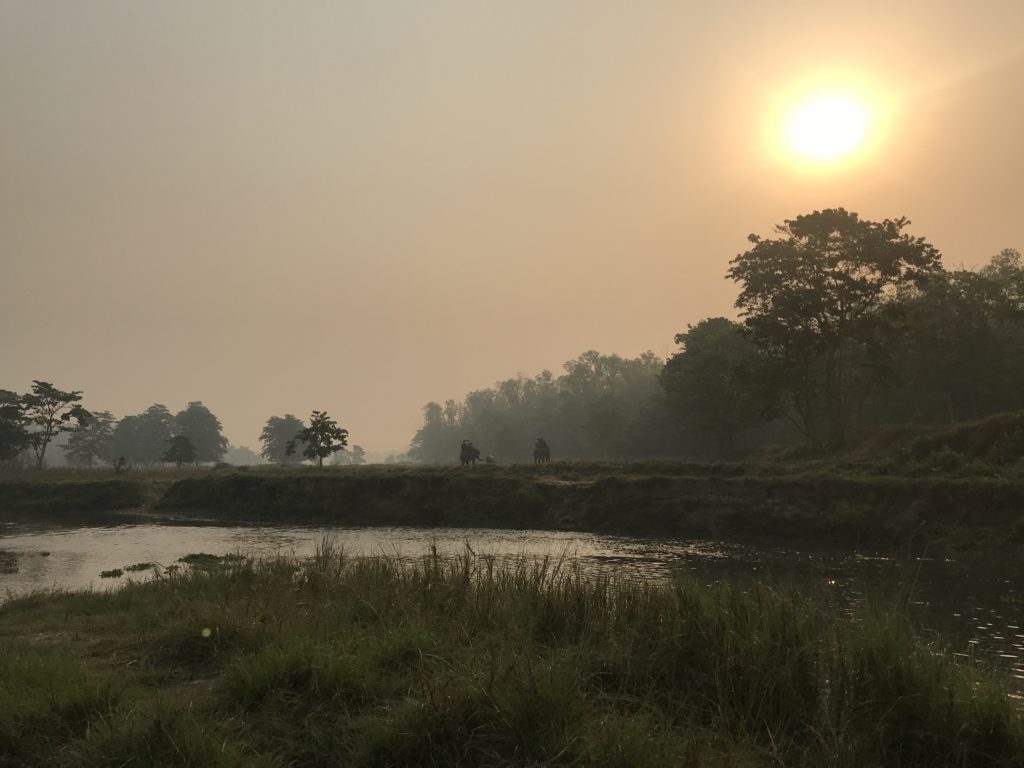

From Chitwan, I took (by Western standards) a painfully slow bus ride back to Kathmandu. Per usual, the driver of the large coach had no reservations with making dicey passes by large trucks around blind corners on a road constantly flanked by dangerous cliffs on one side. Every small bridge we crossed over seemed to have a large section of railings torn open where a vehicle clearly plunged over the side. Peering down one such spot, I could see the crushed remains of a car far below on the bottom of the cliff. At another spot, a large truck had been in an accident, with most of the front cab dangling off the edge of a cliff. This journey of 100 miles that would have taken under two hours in many countries took seven hours here. But this is standard fare in a country with limited resources forced to build and maintain roads on such a challenging topography.
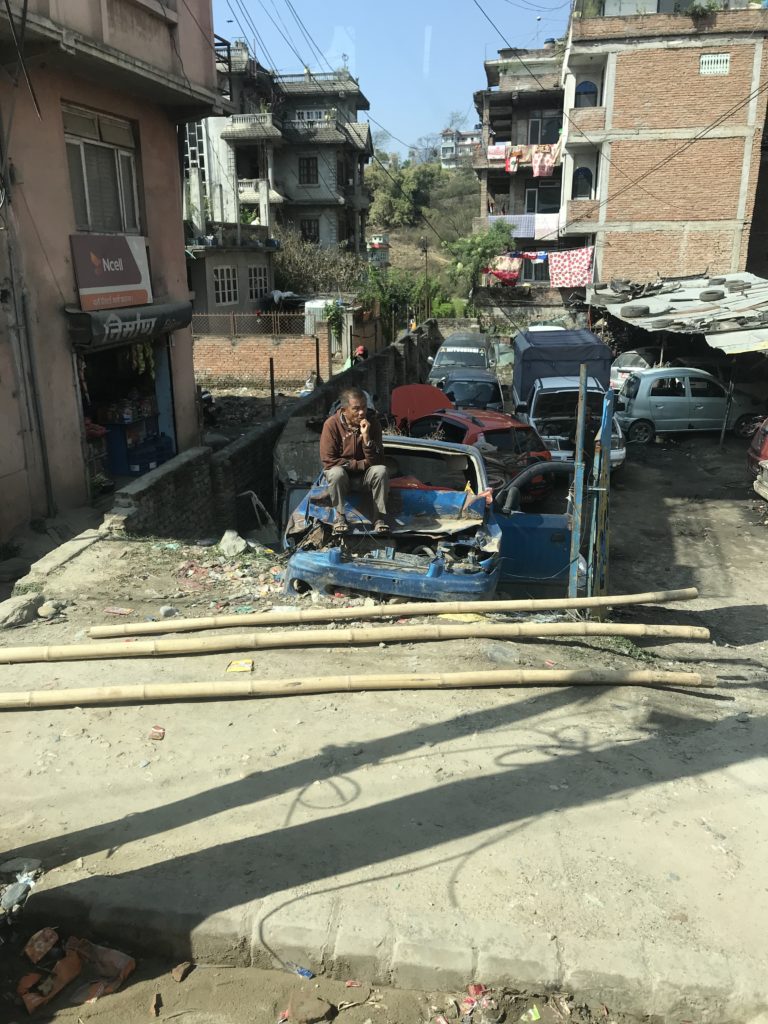
The following day I visited the incredibly old and unique World Heritage Site city of Bhaktapur and soon after was on a flight to Delhi. The Nepal leg of my trip had come to an end and now it was time to meet my wife Pam in southern Spain for a week. I had to lobby pretty hard to get three weeks in Nepal on my own so a romantic reconvening in Andalucía was a concession I was happy to make.
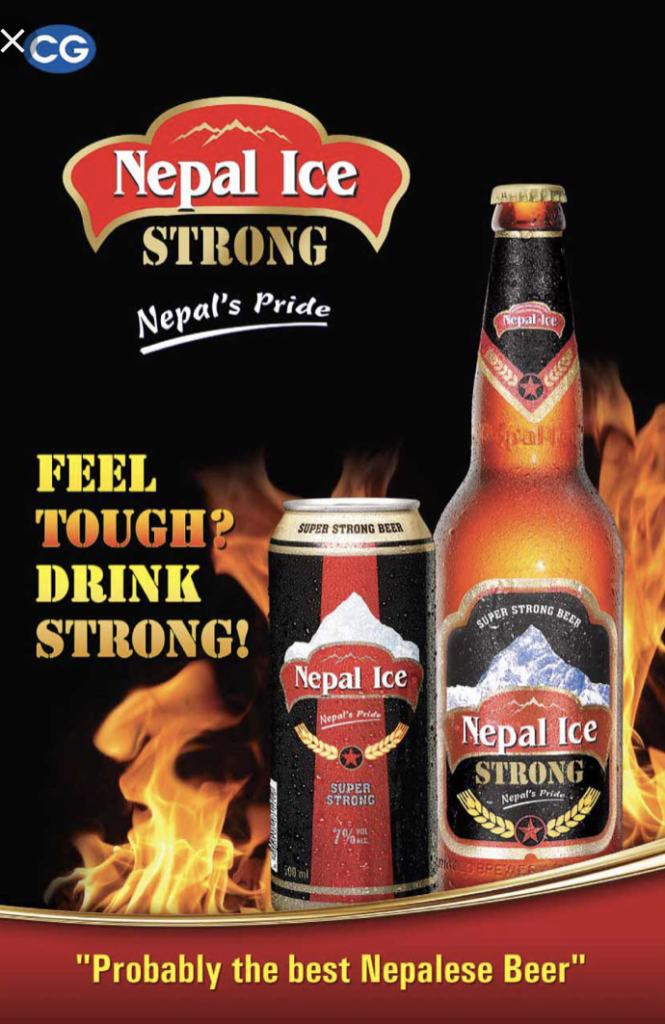
We don’t want to come across as overconfident but our beer is “Probably the best Nepalese Beer”. I am convinced that this advertisement is aimed at American junior high students.
Due to the continuing closure of Pakistan airspace, my connecting flight in Delhi was forced to depart two hours earlier forcing me to arrive in Delhi 20 hours earlier. Without an Indian visa, I elected to stay in a transit hotel in the airport. It was like sleeping over in a mall; when I exited the hotel, I was free to wander around the food court, duty-free shops, and departure gates. In the morning, I luxuriously sipped coffee in the large private dining area while watching planes take off. From a distance, I must have looked like a boring but content human in an architect’s rendering of a potential future airport hotel. I love the people in those architectural drawings; no one is fat and everybody’s shirt is tucked in.
The Spain part of this journal will be somewhat brief. The trip was culturally vibrant but tame. This is a good thing. Since Pam and I would be reuniting for eight days, I was in the mood for a week of calm. I flew into Malaga a day before Pam and was able to walk around the city; I even managed to ascend the sobering number of meters to the Alcazaba only to find they did not accept credit cards as a form of payment of the entry fee. With no ATM’s or exchange services, I was forced to sulk my way down to city center.
When I did pick up Pam in the rental car, I was unfashionably 40 minutes late which seriously watered down the joy of our reunion after three weeks apart. I told her that Google erroneously told me that her flight was delayed. Thankfully, it only took five minutes for Pam to lose her gurl-none-too-pleased face.
On our way to our guest house, Perla Blanca near Ronda, I savored the absence of every bump and hole in the road. I too savored the absence of impending landslides, traffic, noise, pollution, and litter. Nepal is a lovely, one of a kind place (especially in the mountains) with some of the kindest people on the planet but the cleanliness and order of Spain (never thought I would say that) was a thing I wanted to hug.
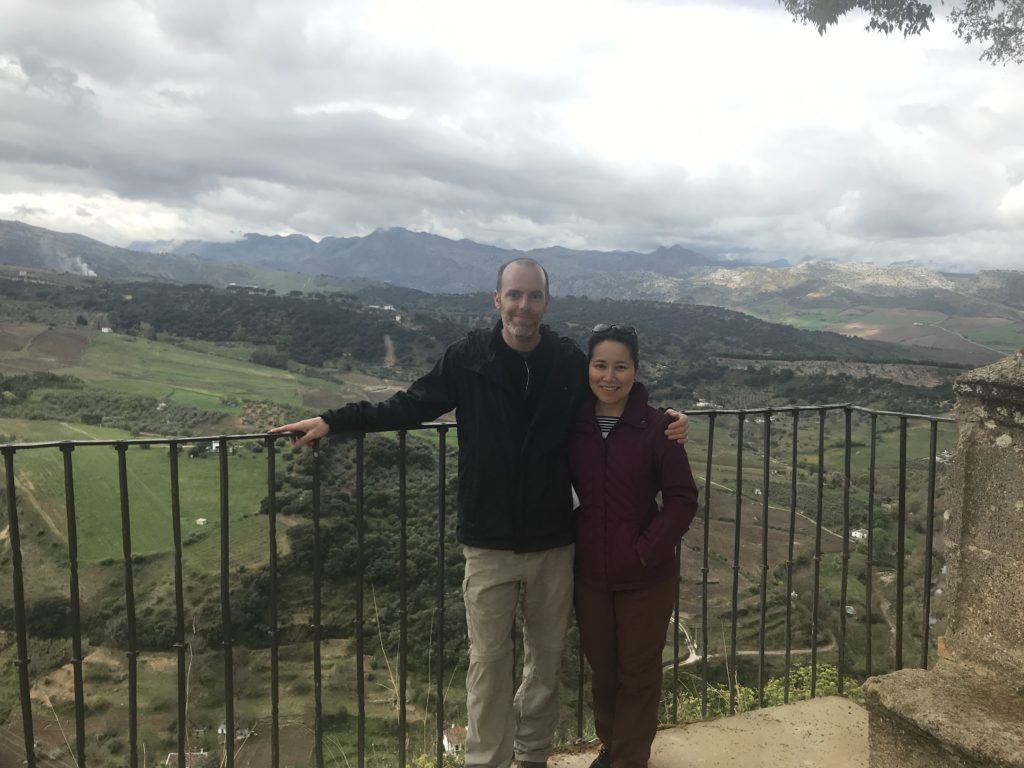
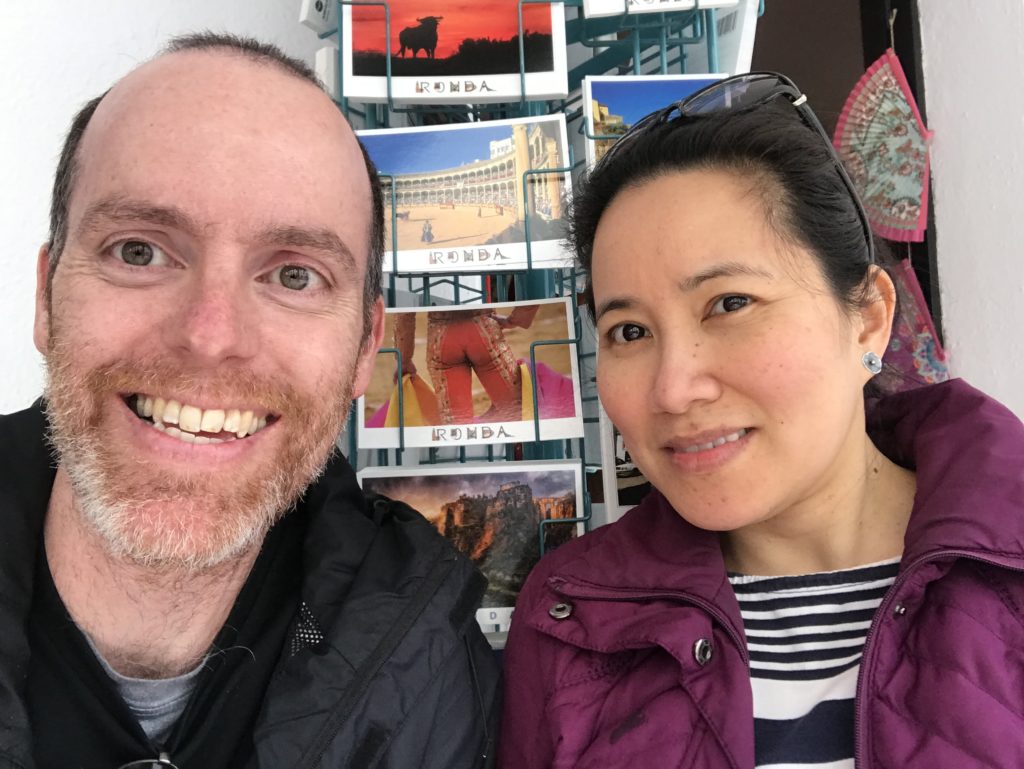
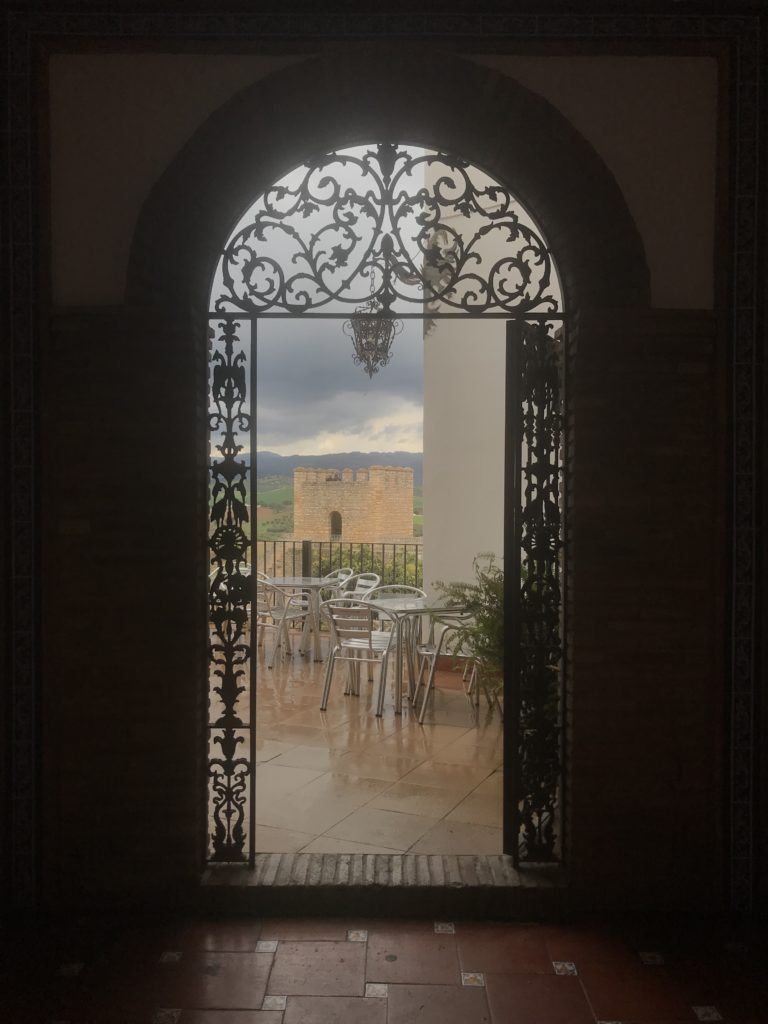
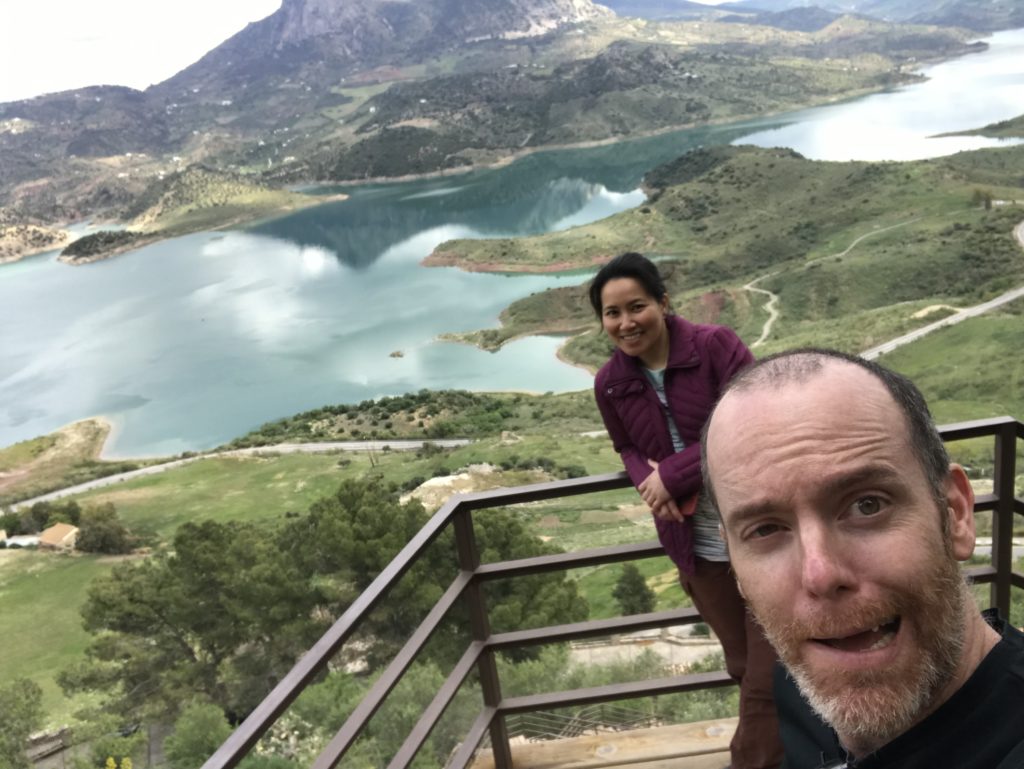

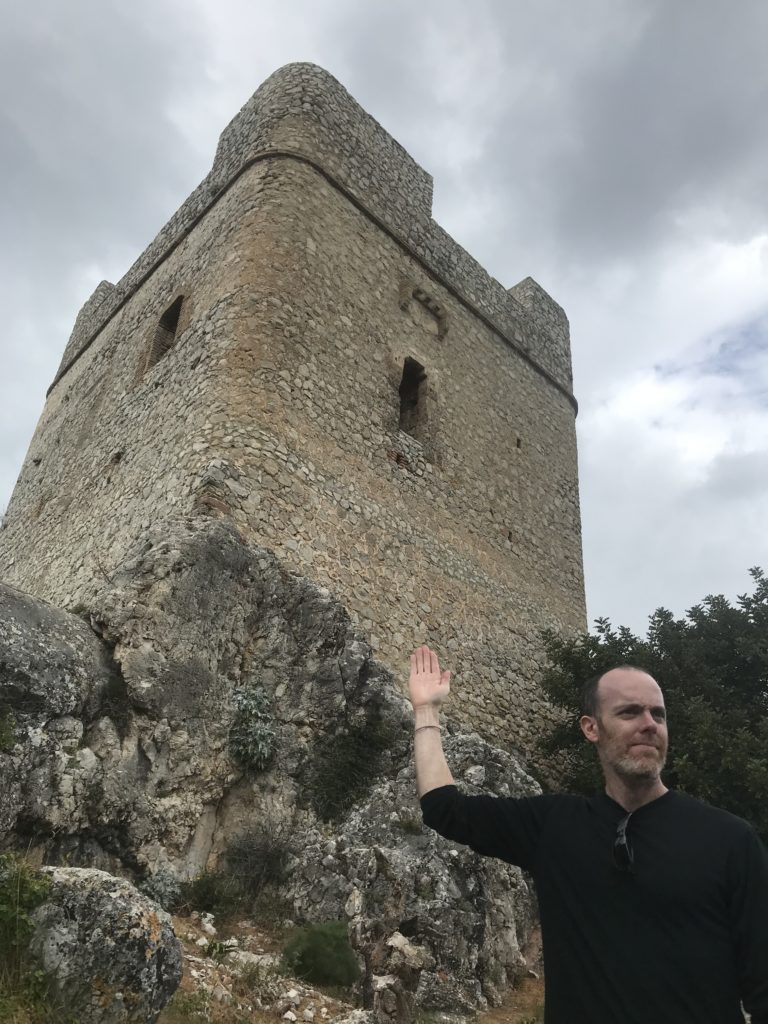
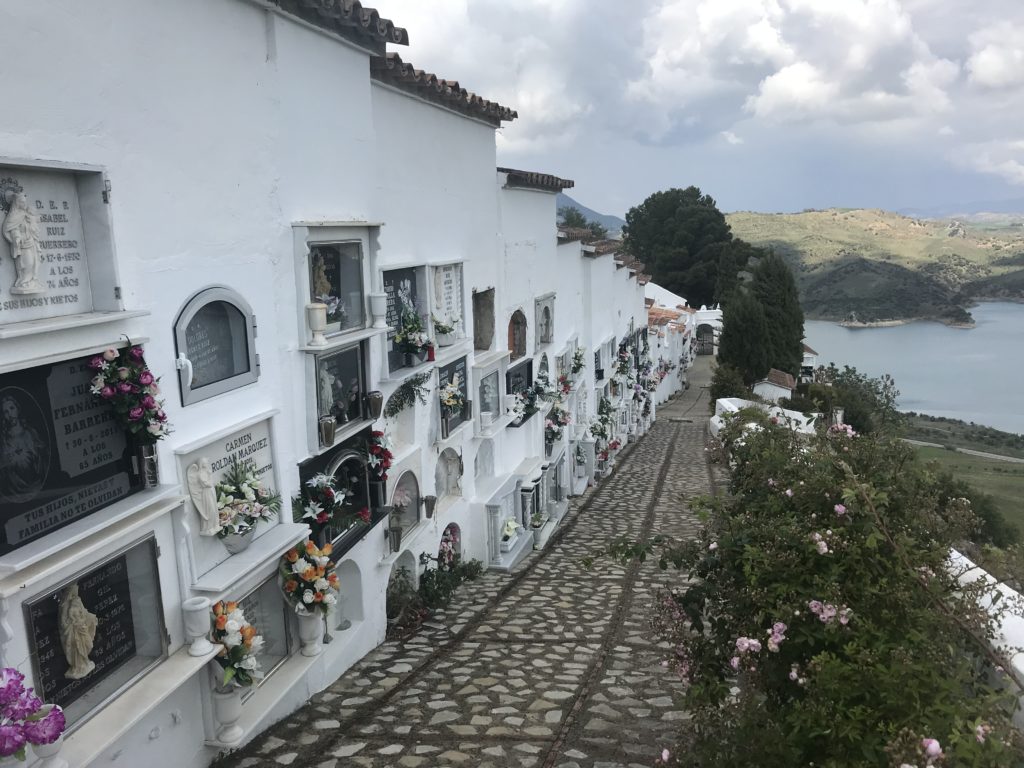
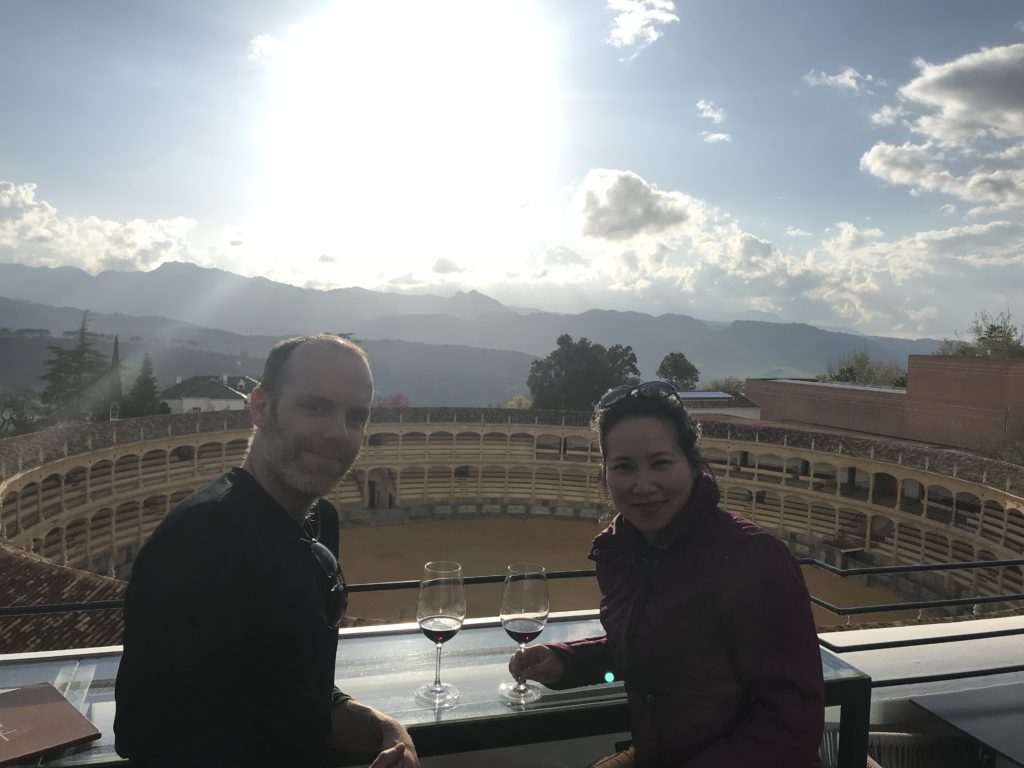
After a few days in Ronda, we stayed at a nice guest house near Rio Gordo. One day we made a day trip to Comares. Getting to and from this little gem of village required some winding road driving. After several days of such driving, Pam’s equilibrium had said “no more” and once returning to the guest house, Pam promptly barfed her way to the top for the next couple of hours.
The last destination of our Andalucía affair was the hyper romantic and picturesque village of Frigliana. Like so many small villages in the south, all the buildings were white and huddled together, producing narrow, often maze-like corridors. Cats and flowers were to be found everywhere in this dream-like place.
To complete the pursuit of romance, Pam and I made plans to watch a Flamenco show in nearby Velez-Malaga. That night we decided to arrive a couple hours early to eat dinner and walk around. We parked our car near the performance space and elected to walk by to make sure we had the right address. Standing in front of the door was a man who could not have personified the veteran Spanish artist any more than our soon to be friend, Pedro. At 49, his hair was full of just the right amount of gray although it was mostly covered by an obligatory beret. His beard was shorter on the sides but gradually faded to a goatee area that was slightly longer and came to the perfect peak on his chin. A thin scarf was wrapped around his neck and draped over a wool jacket that, like his pants below whose pattern almost had a pinstripe look to them, were gloriously second hand. After we realized we would be going to the same show later, Pedro asked if he could join us for dinner. Pam was thrown off balance by this bold invitation but I was not going to pass up this chance of breaking bread and making chat with an authentic local.
He took us to a nearby restaurant with well-made cuisine and when I offered to cover the bill, I met little resistance. Pedro was an artist to the core and could not be bothered by the pursuit of financial stability. I’m still unsure how he made money but I know that photography, Iyengar yoga, and travel were among the many passions in his life. Pedro could talk to anybody and made friends with alarming ease. When he discovered Pam was from the Philippines, he excitedly called his one and only Filipina friend, Belen, and gave the phone to Pam so the two could talk.
After dinner we walked back to the performance space. It turned out we needed a reservation but unsurprisingly, Pedro talked to the doorman and made quick work of this obstacle. I enjoyed watching Pedro in action. He was a man not to be found in the US. His confidence was refined by an older world and culture.
The show itself was easily the best flamenco I’ve ever seen. In a small space in a basement, the performance felt less like a show and more like an unplanned spectacle. A guitarist and singer did their part while a female dancer in her early forties profoundly and mercilessly dominated the consciousness of every single audience member. Although the entire performance was little more than 70 minutes, I’m convinced those present could handle no more. We said goodbye to Pedro and drove home. Pedro, true to form, lingered at the club until four in the morning, socializing with the performers and other artists he knew.
The following day we met Pedro and his Filipina friend Belen who brought her Israeli Moroccan Spanish husband Gil along. We decided to meet up at a flea market that happened every Saturday along the coast below Velez-Malaga. As I shouldered my way through the tight corridor between the straight quarter-mile of stalls selling crafts, clothing (much of it used), vegetables, spices, food, and housewares, I could see that this market probably provided the lion’s share of Pedro’s wardrobe.
On our way to a beach side restaurant, we encountered a fascinating artist friend of Pedro’s who lived in a small home right on the water. Although only 48, Javier looked closer to 70. Rail thin, his face was heavily populated by creases. His premature aging I assume was due in large part to his 23-year contest with Parkinson’s disease. Gil told me that Javier was having a “good day” and was able to move around better than normal. Gil and Belen had only known Javier for a year or two but made an admirable effort to include him on various outings and activities.
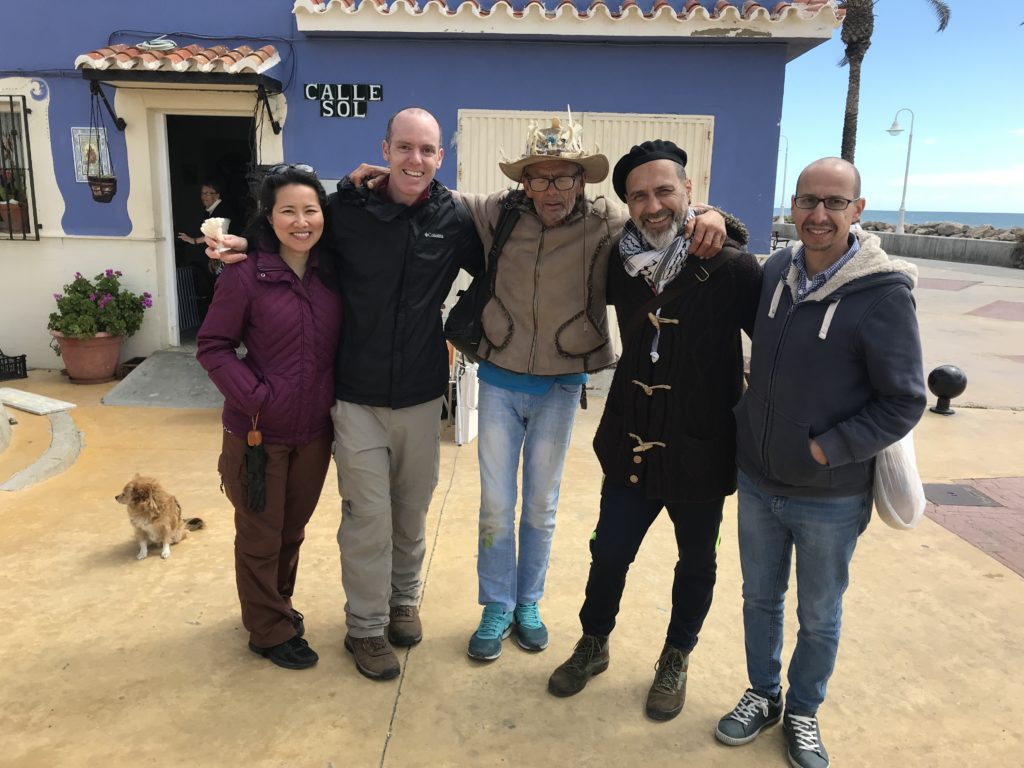
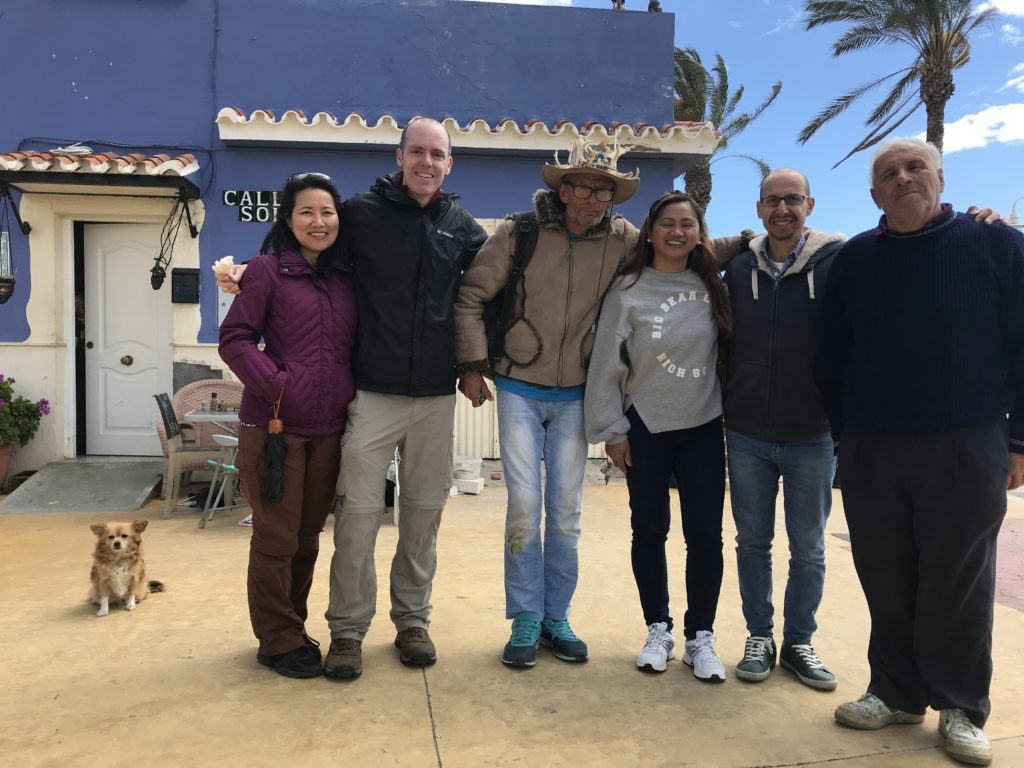
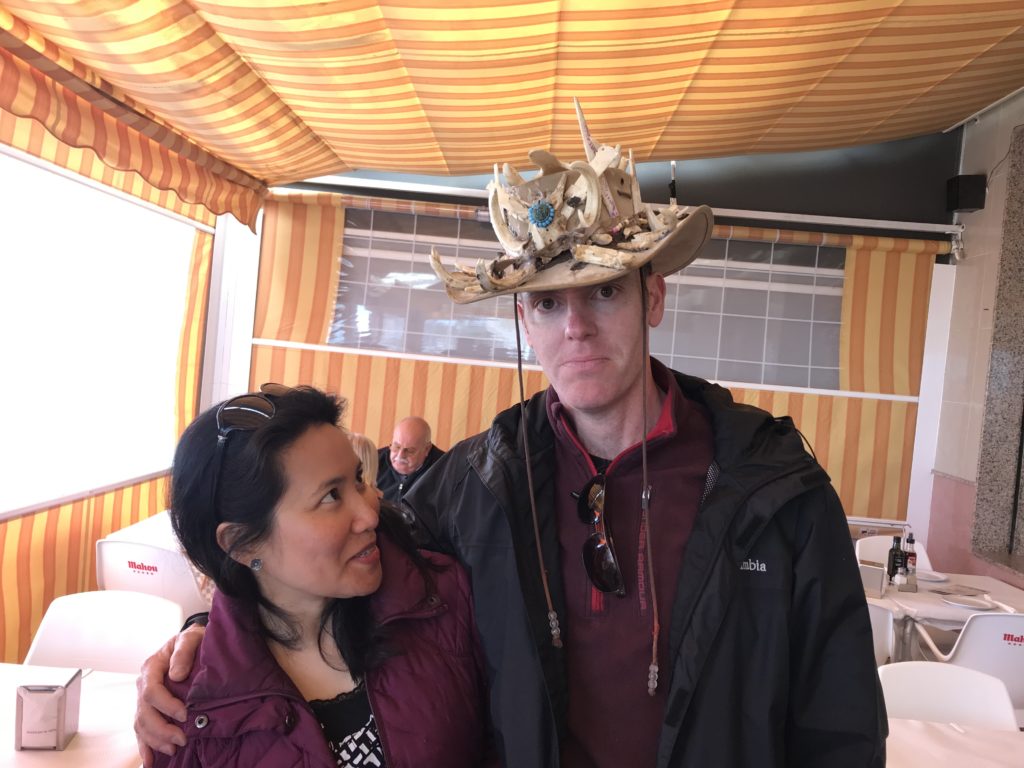
Before we walked the short distance along the boardwalk to the restaurant, Javier opened the door to a sort of storage shed and began to show me the incredible things he’s collected and filed away in this small structure for the past 38 years. There were incredible seashells, bones, dried up old sea turtles, and a six-inch sea fossil that was over 65 million years old. He closed the door to this special private little museum and walked with his uneven but determined gait into his adjoining house where he lived with his mother. A minute later, he returned with a small piece of white coral that had three small seashells glued to the bottom which acted as a stand. He handed it to me and said, “un regalo.”
